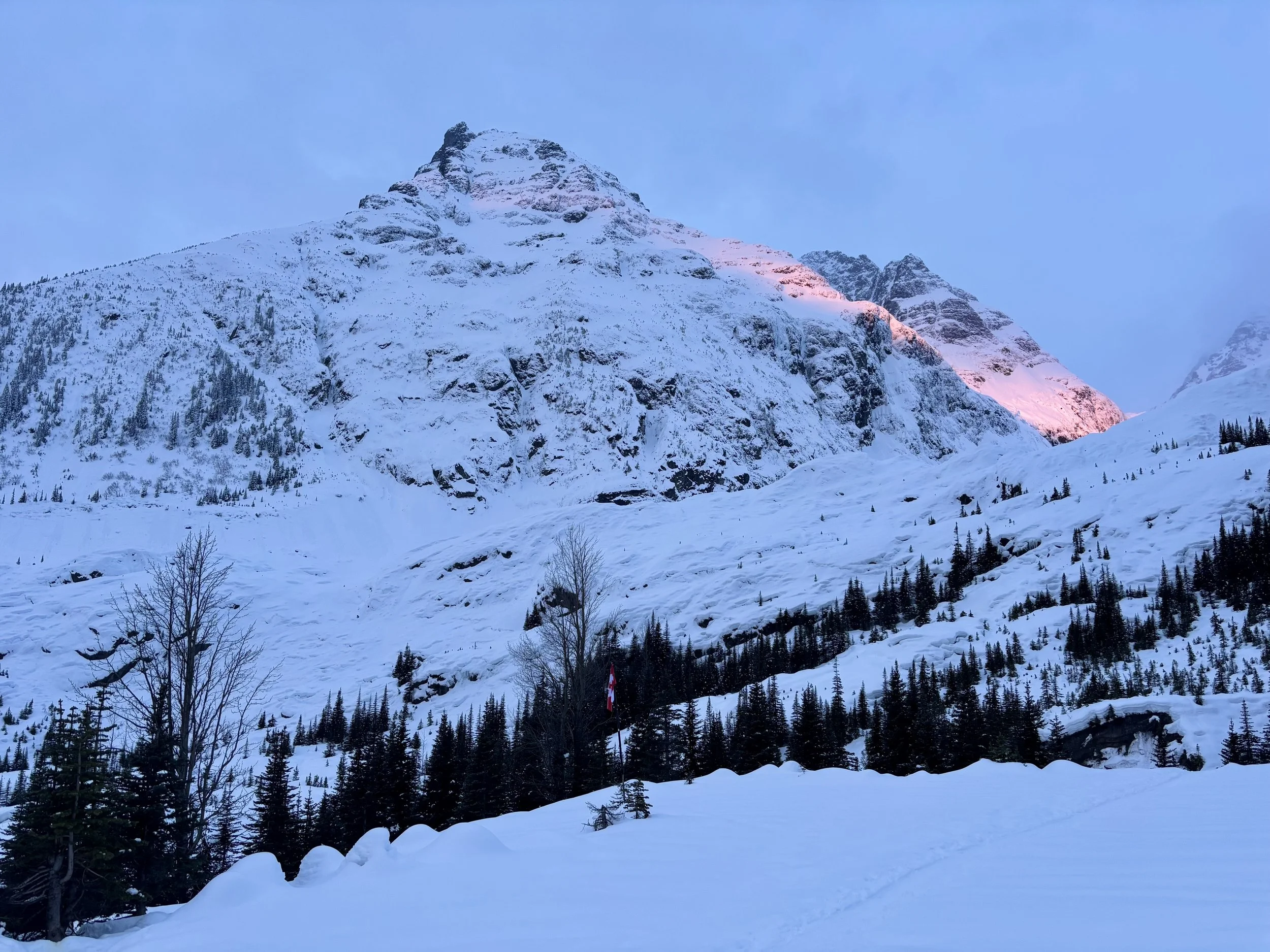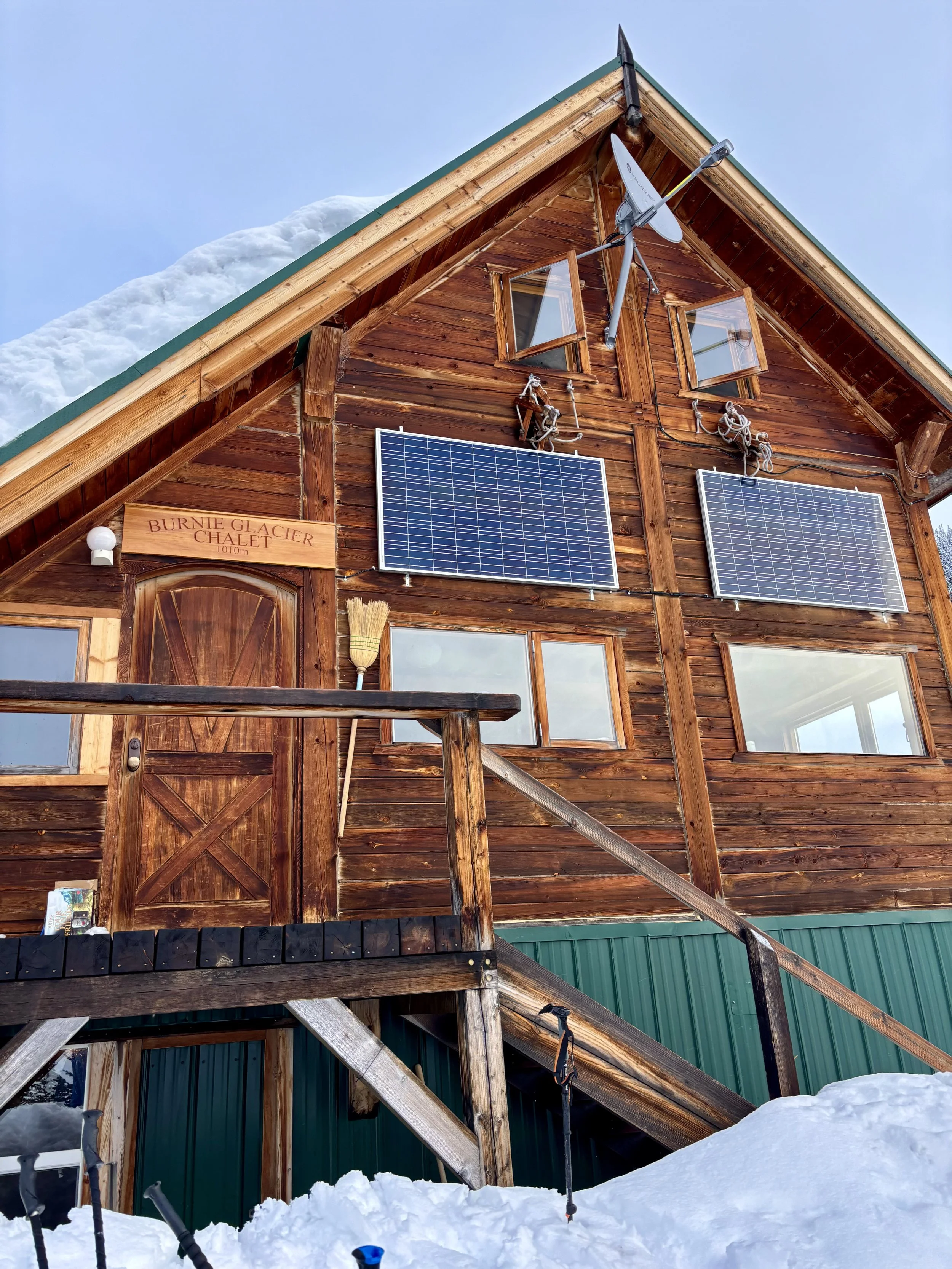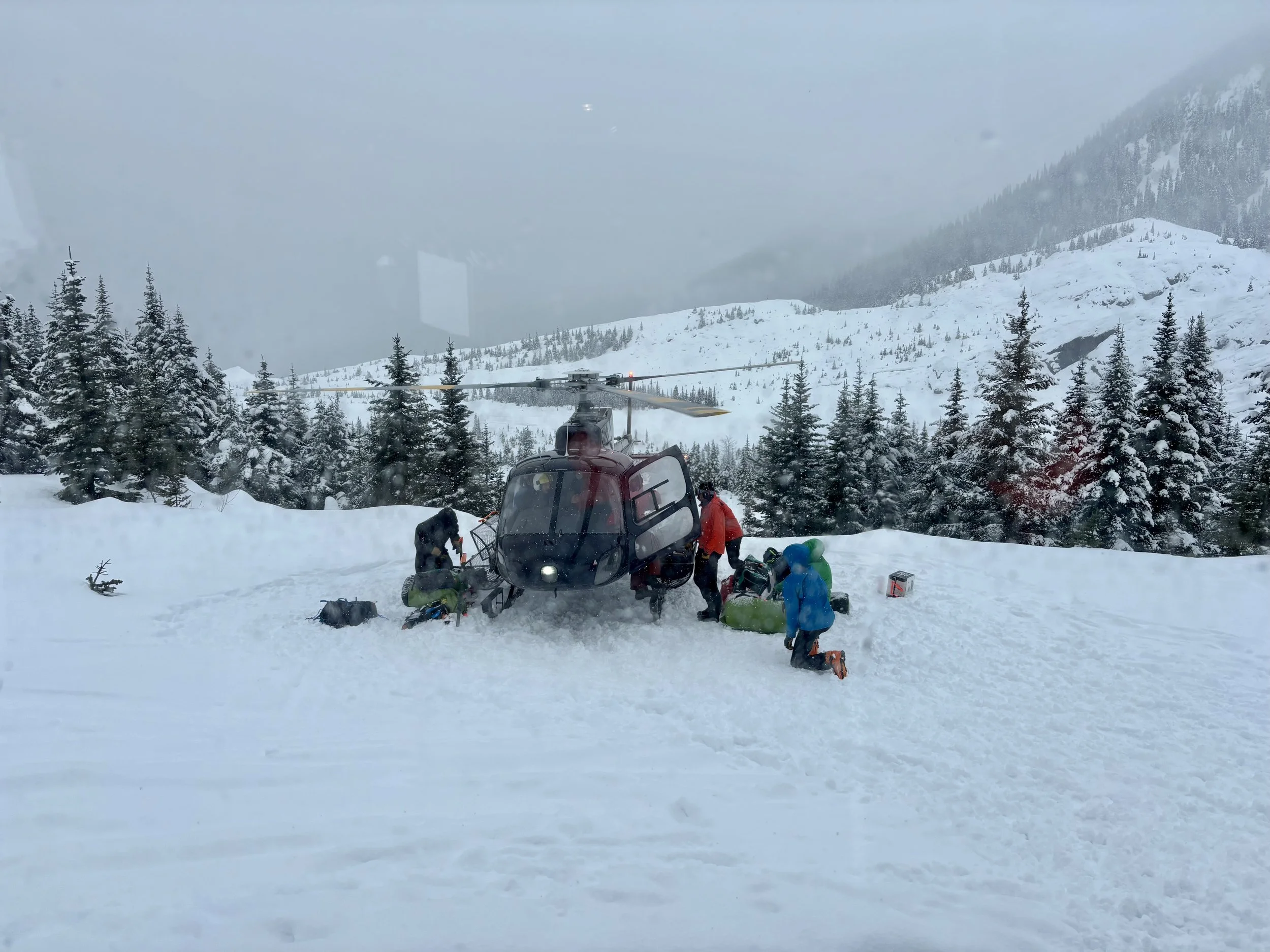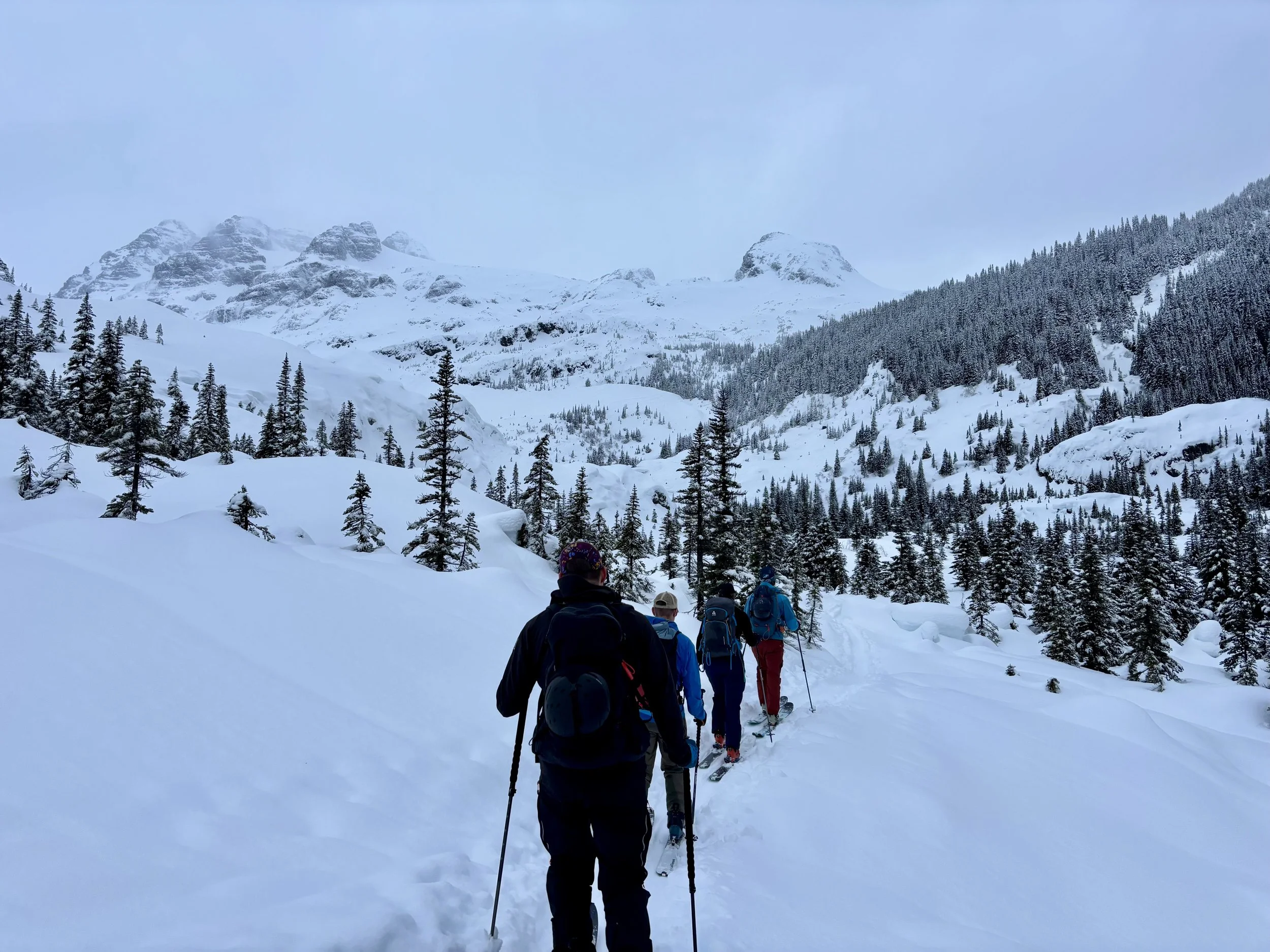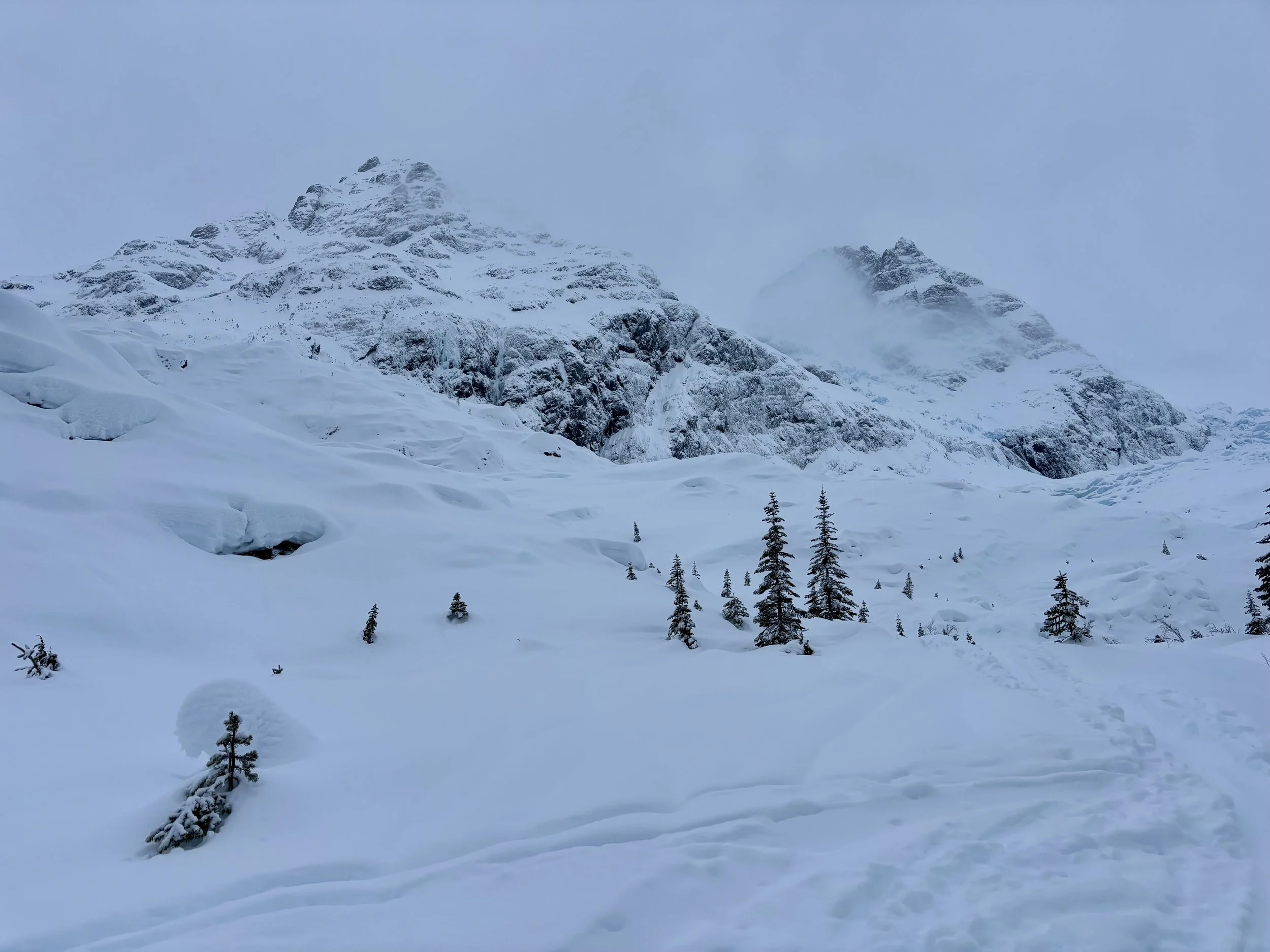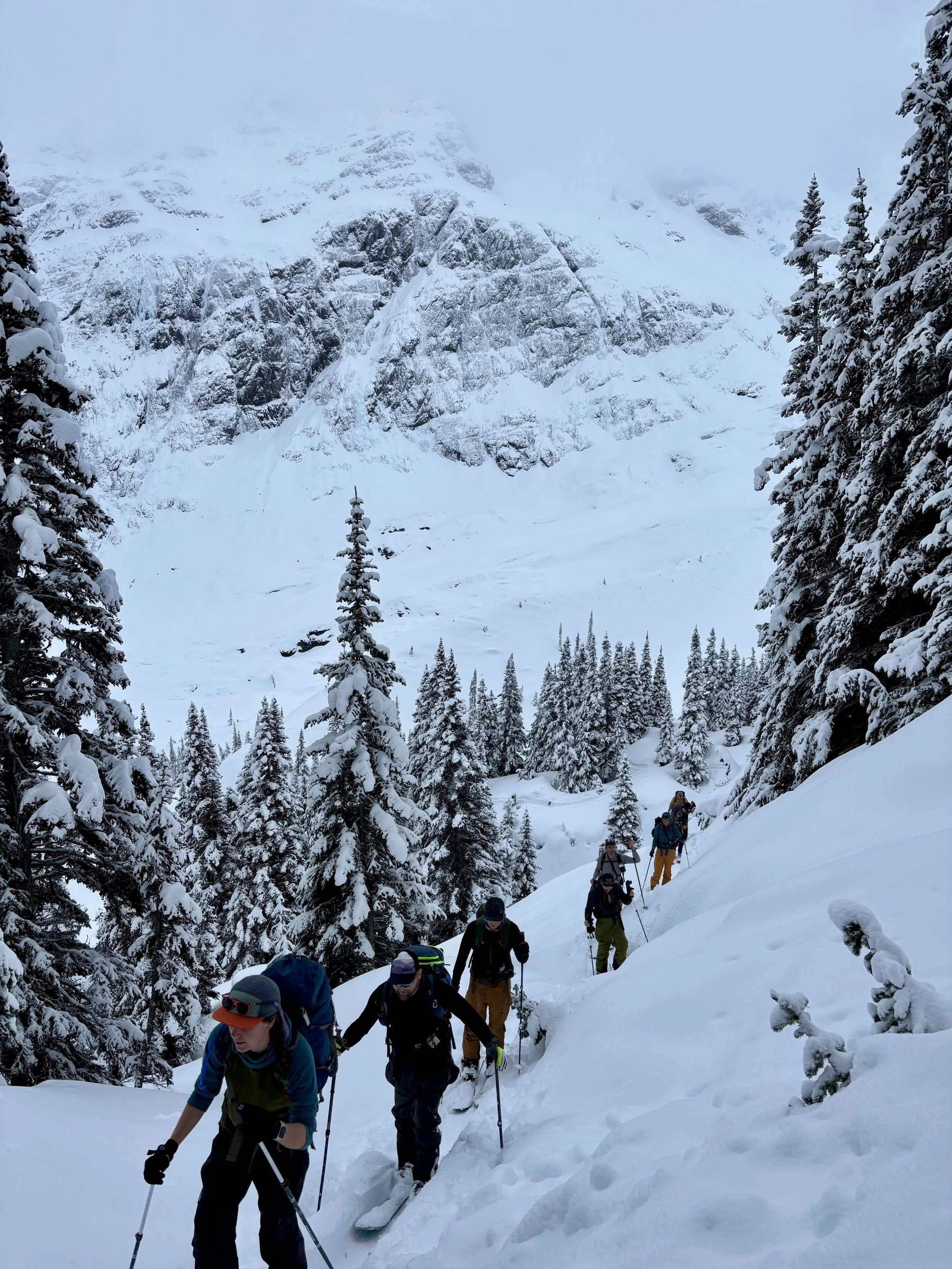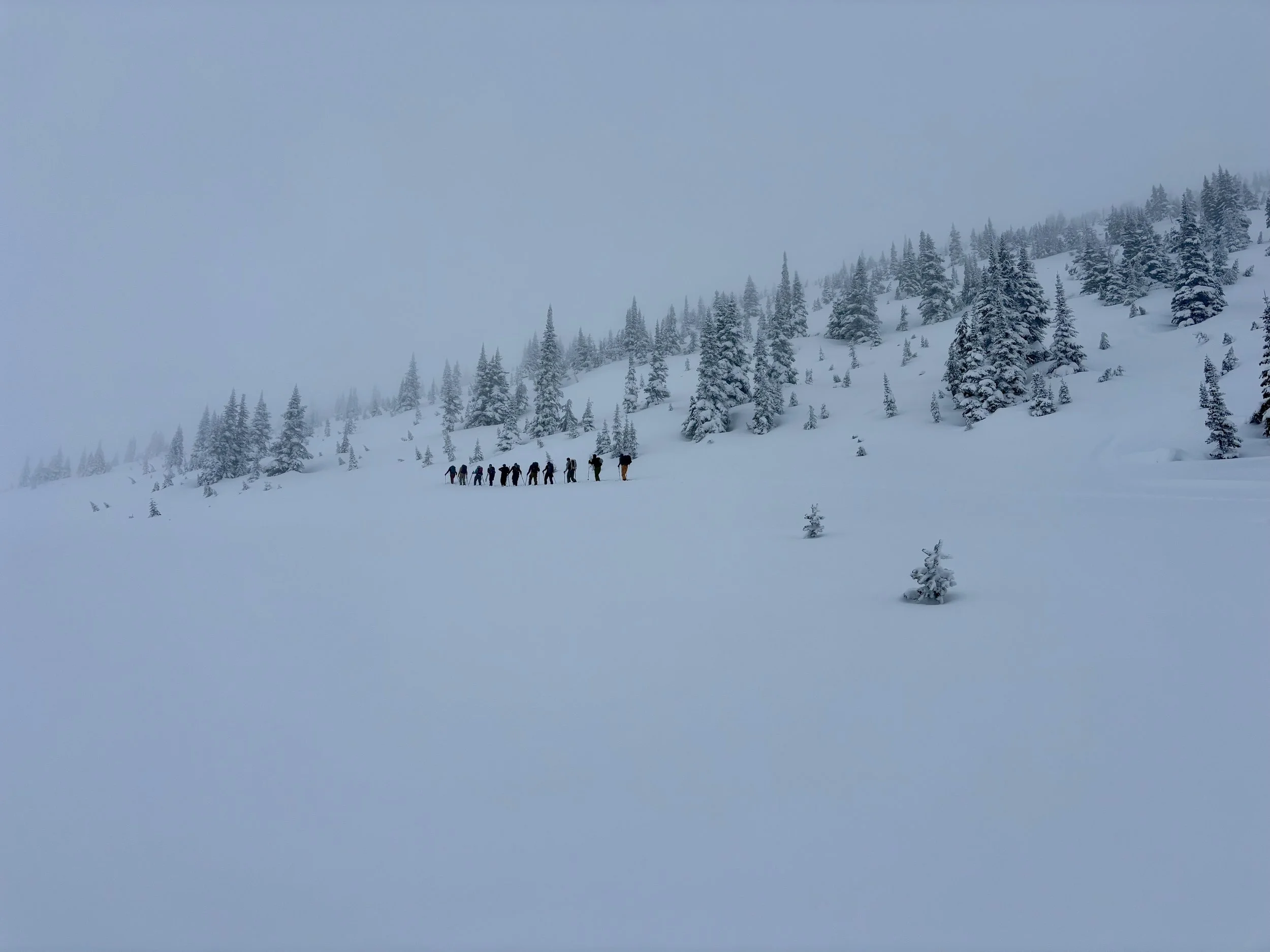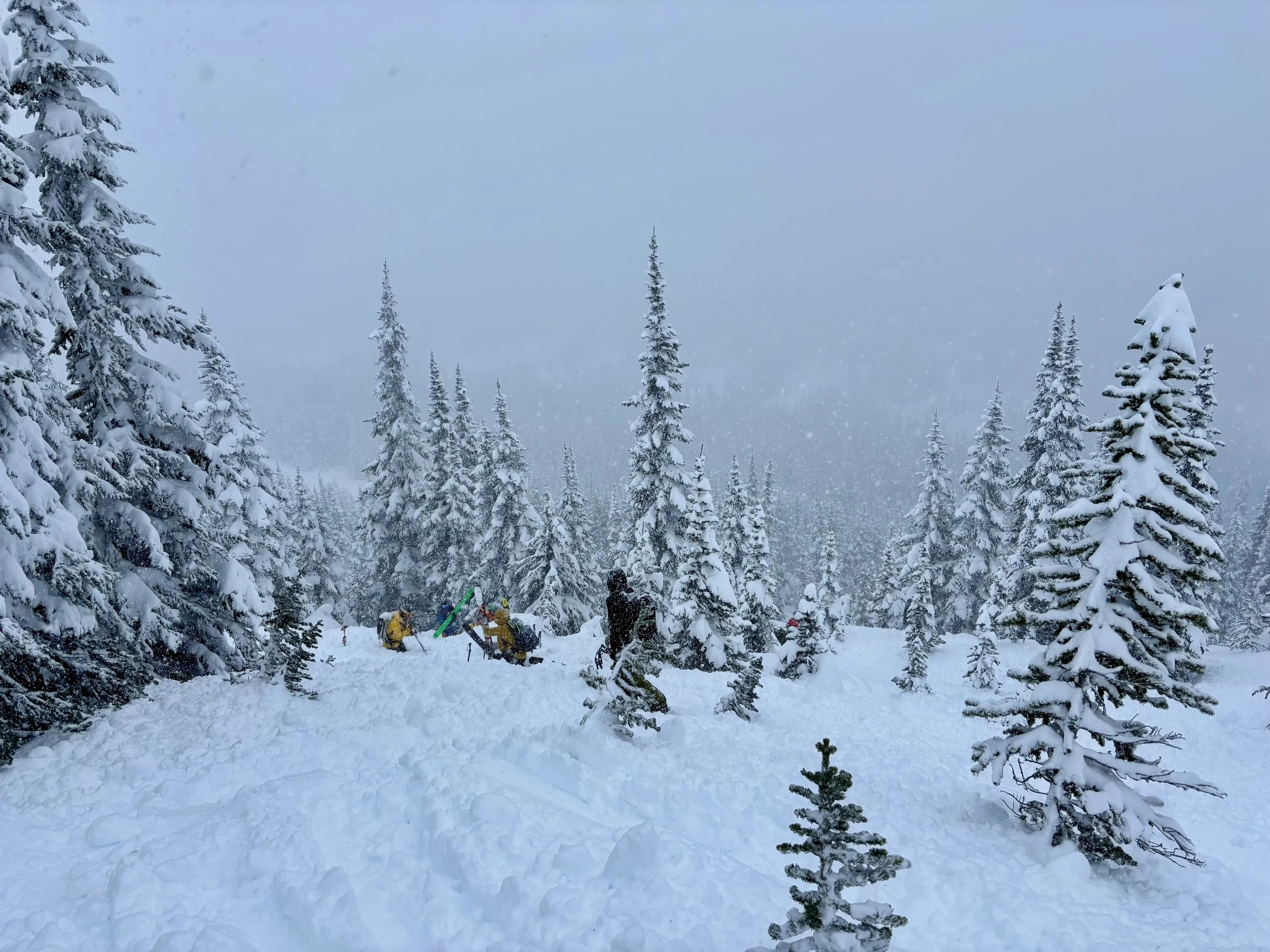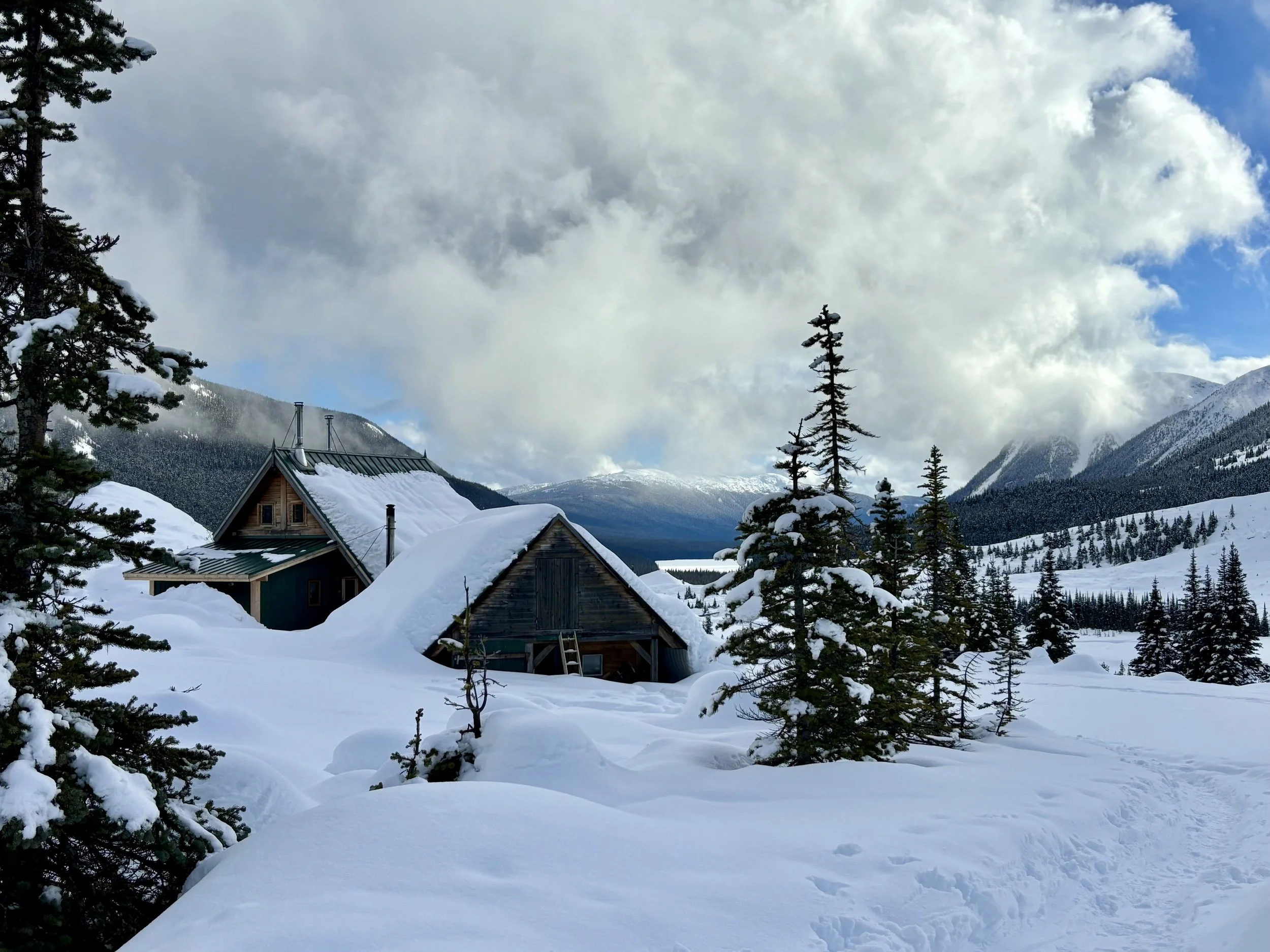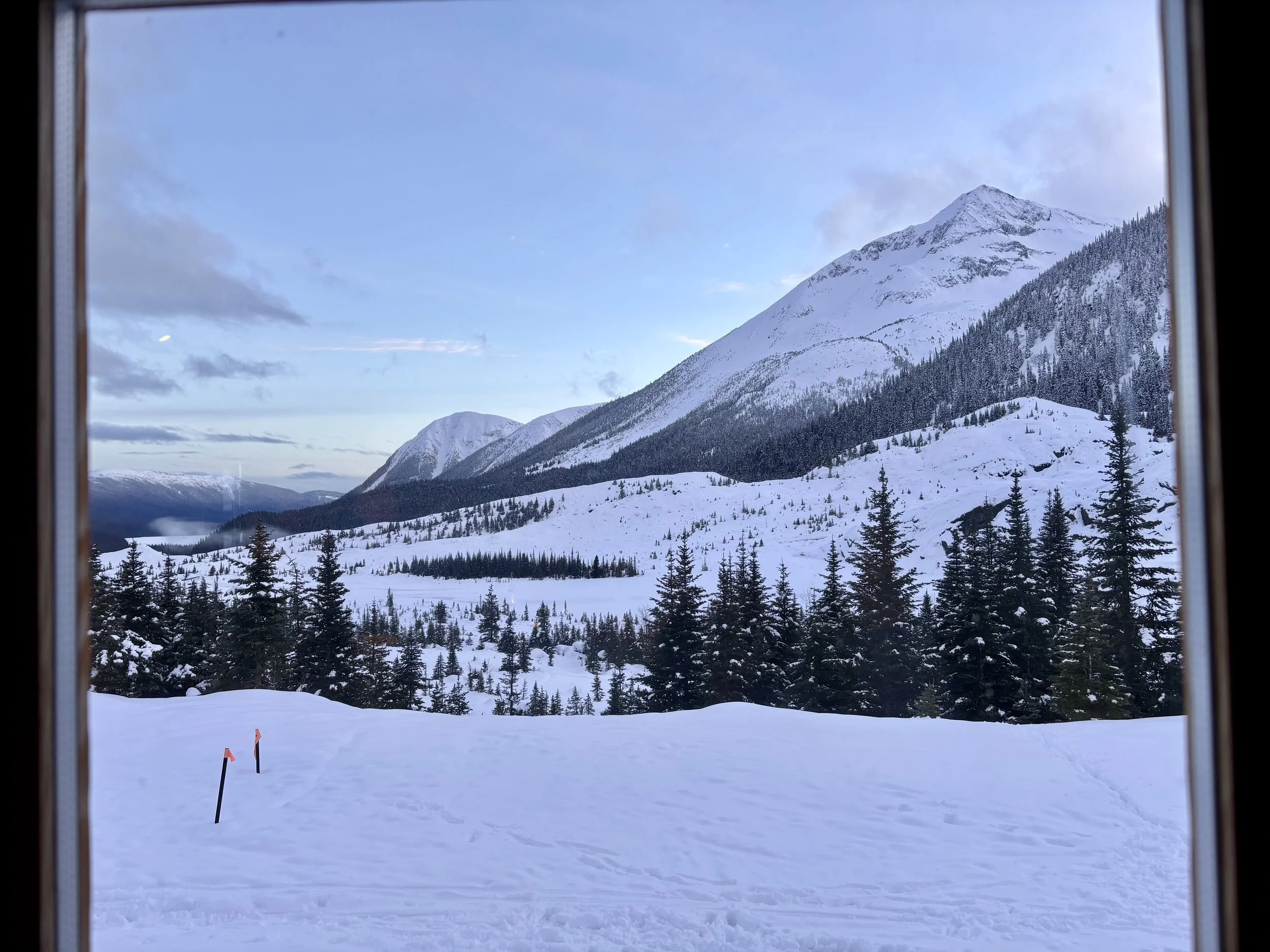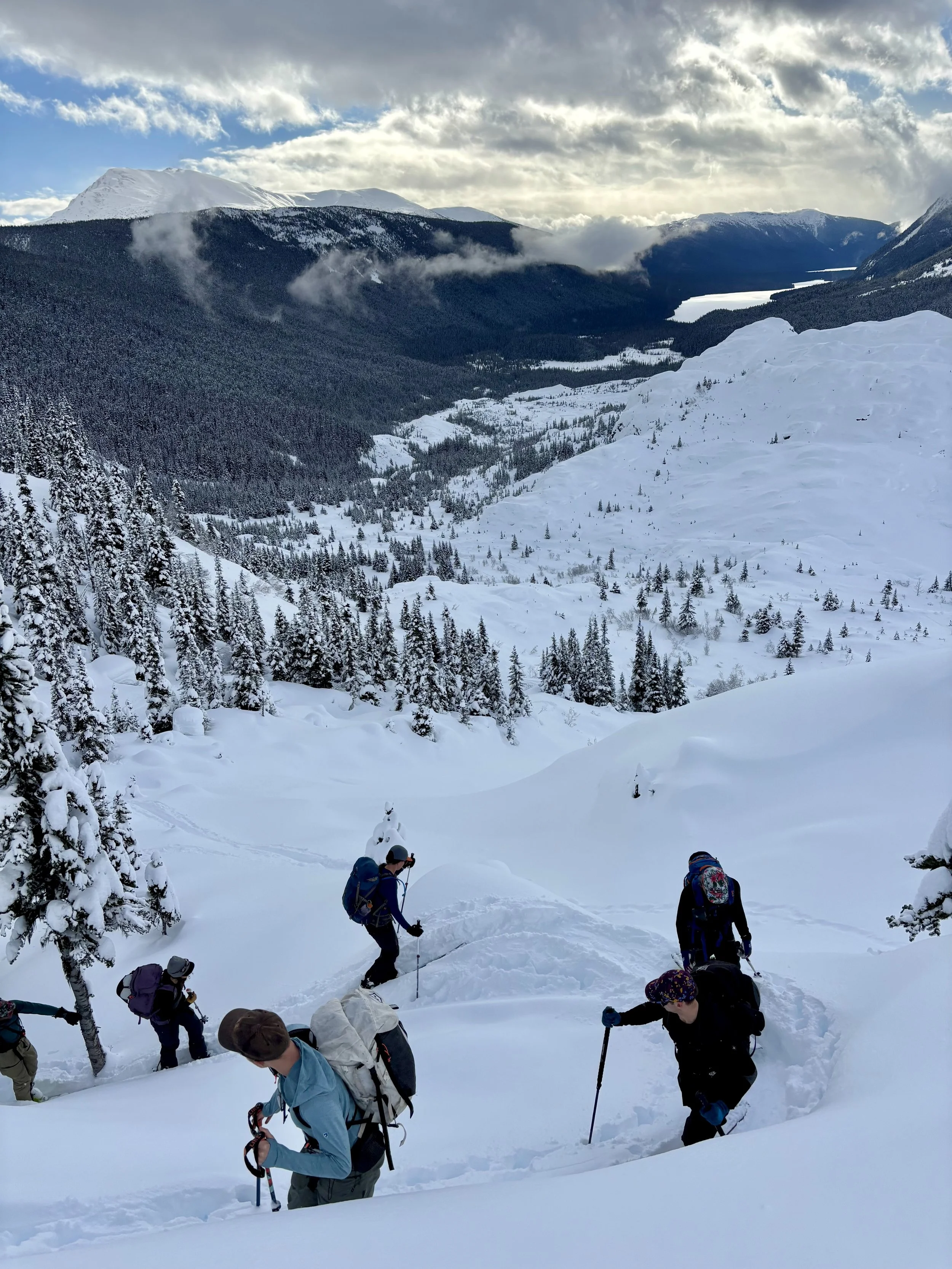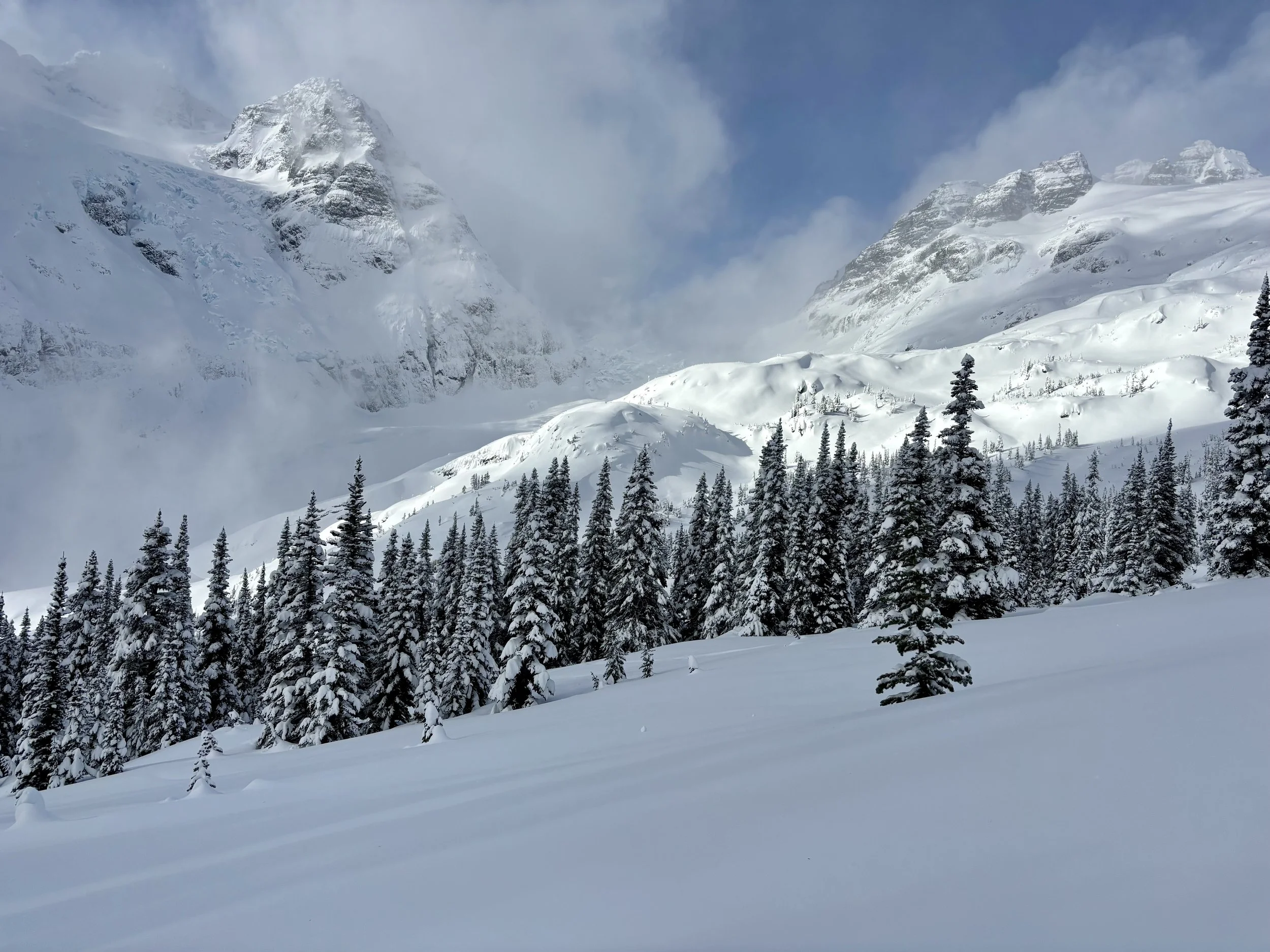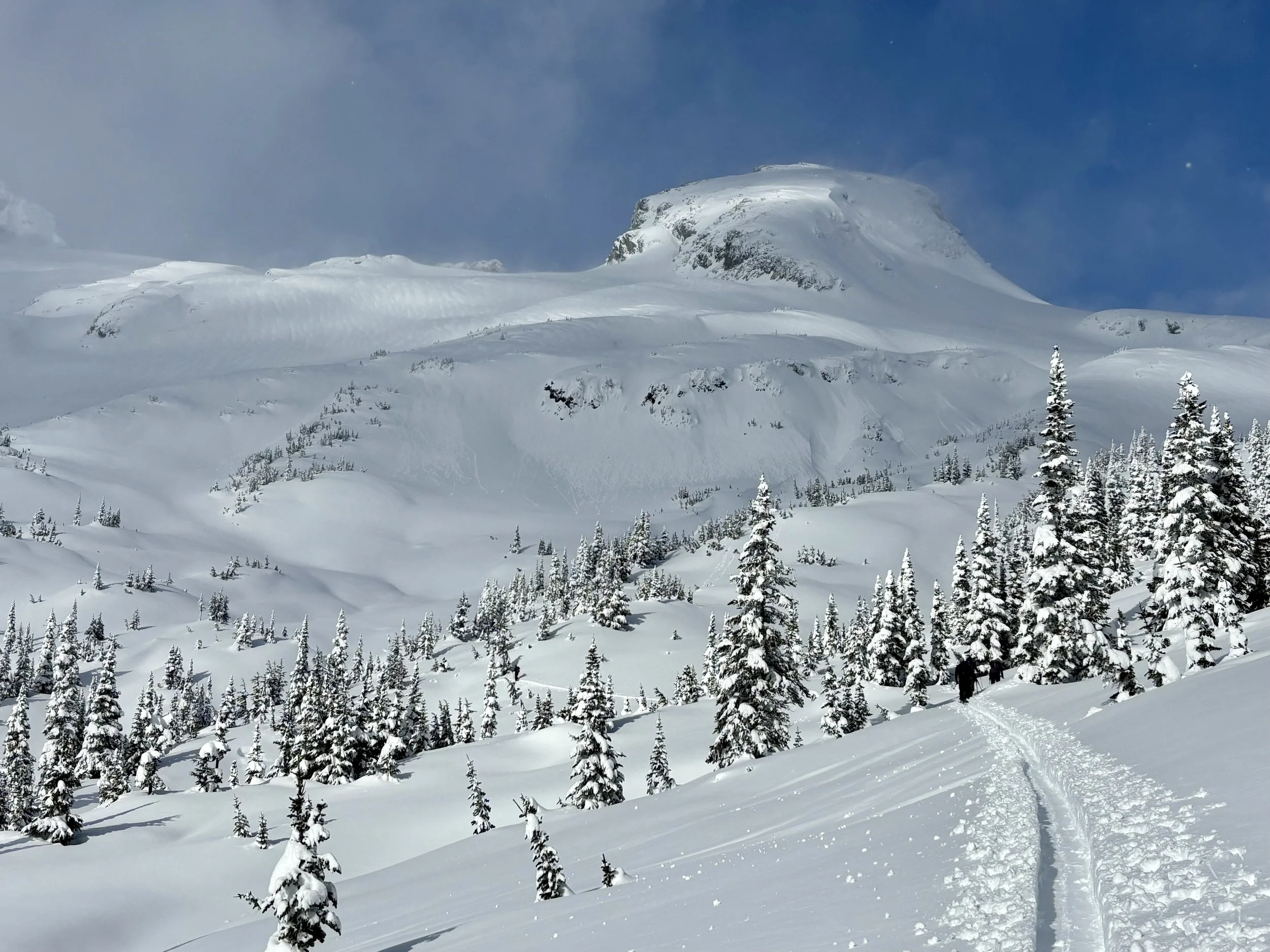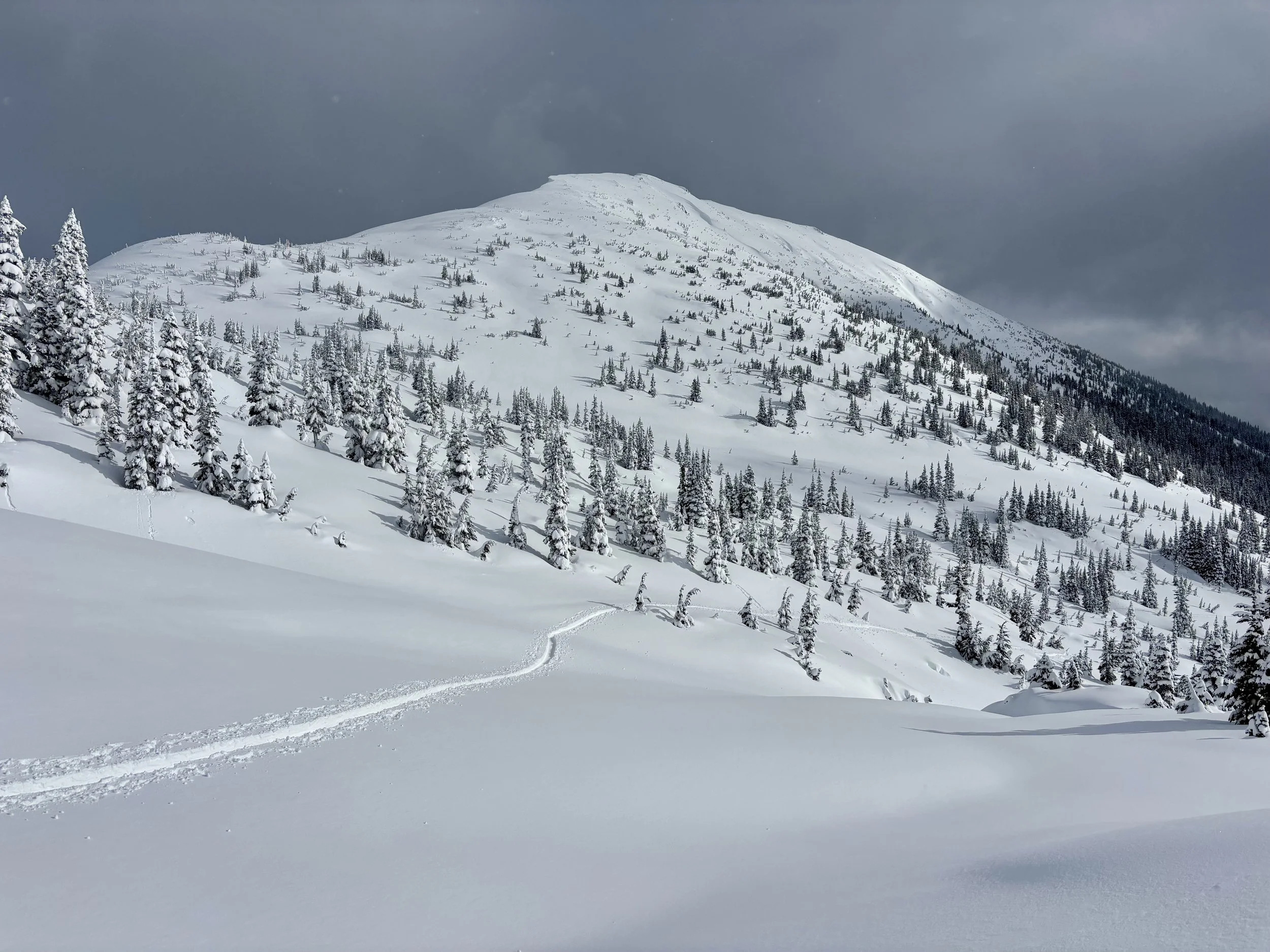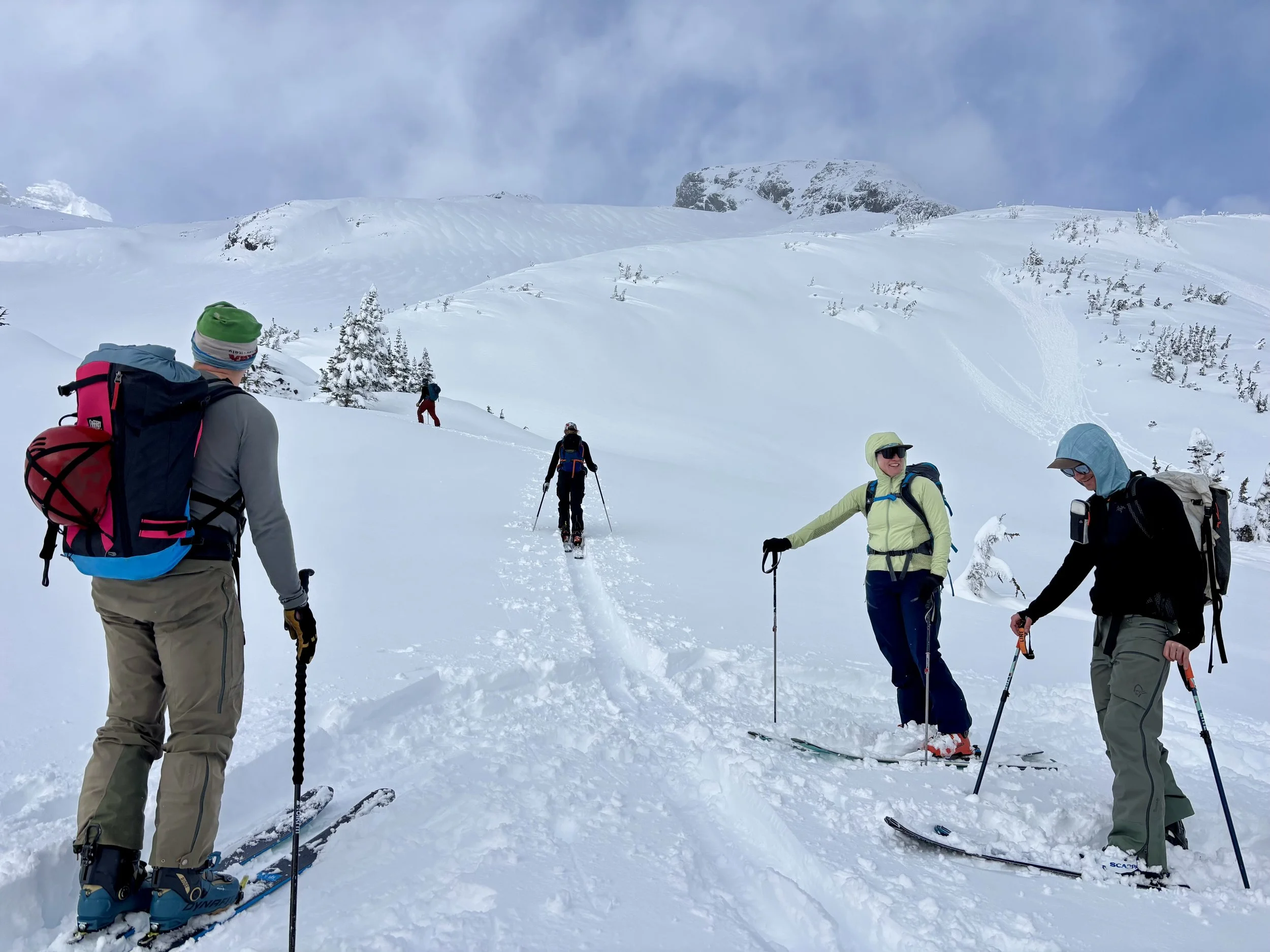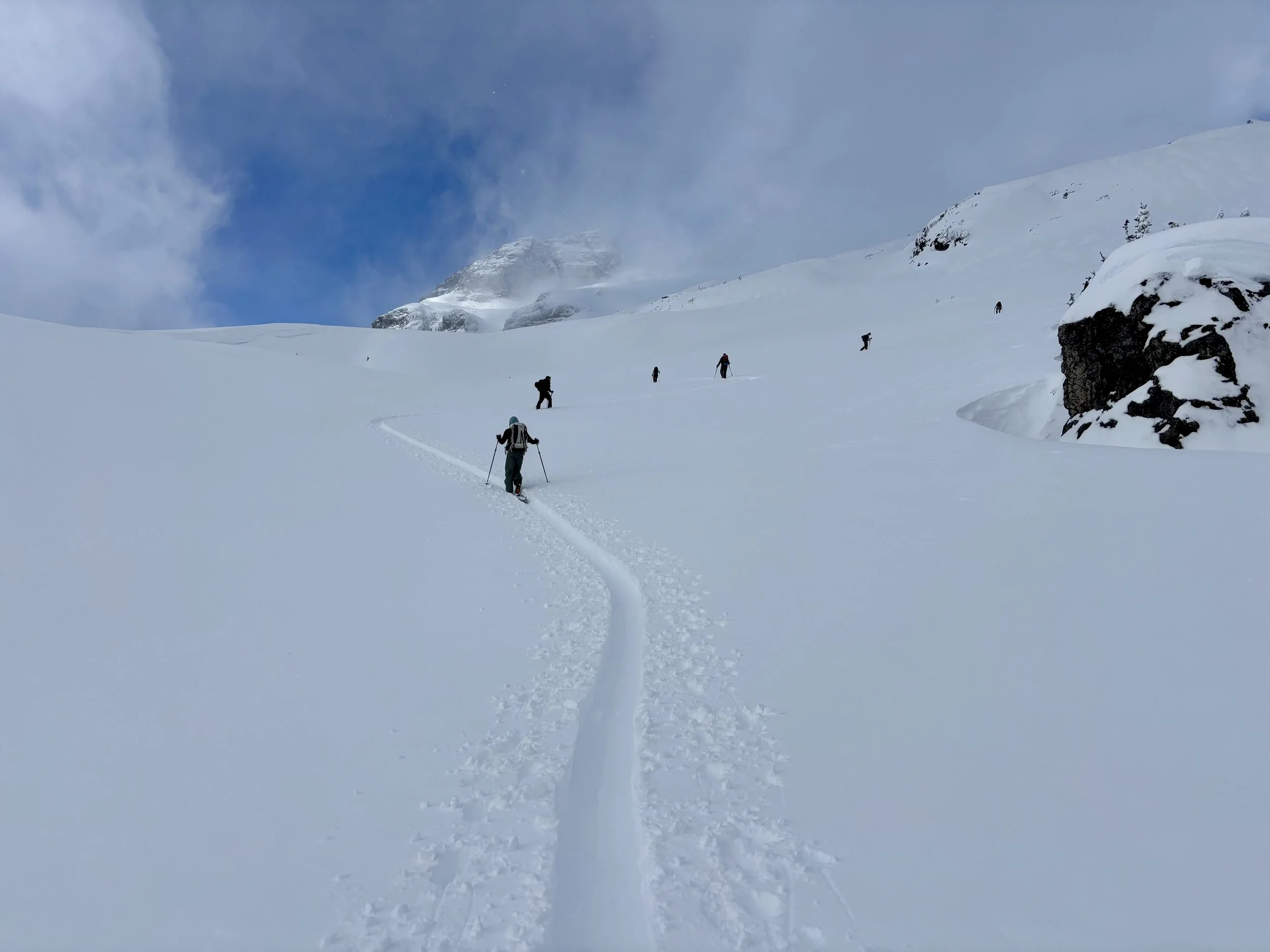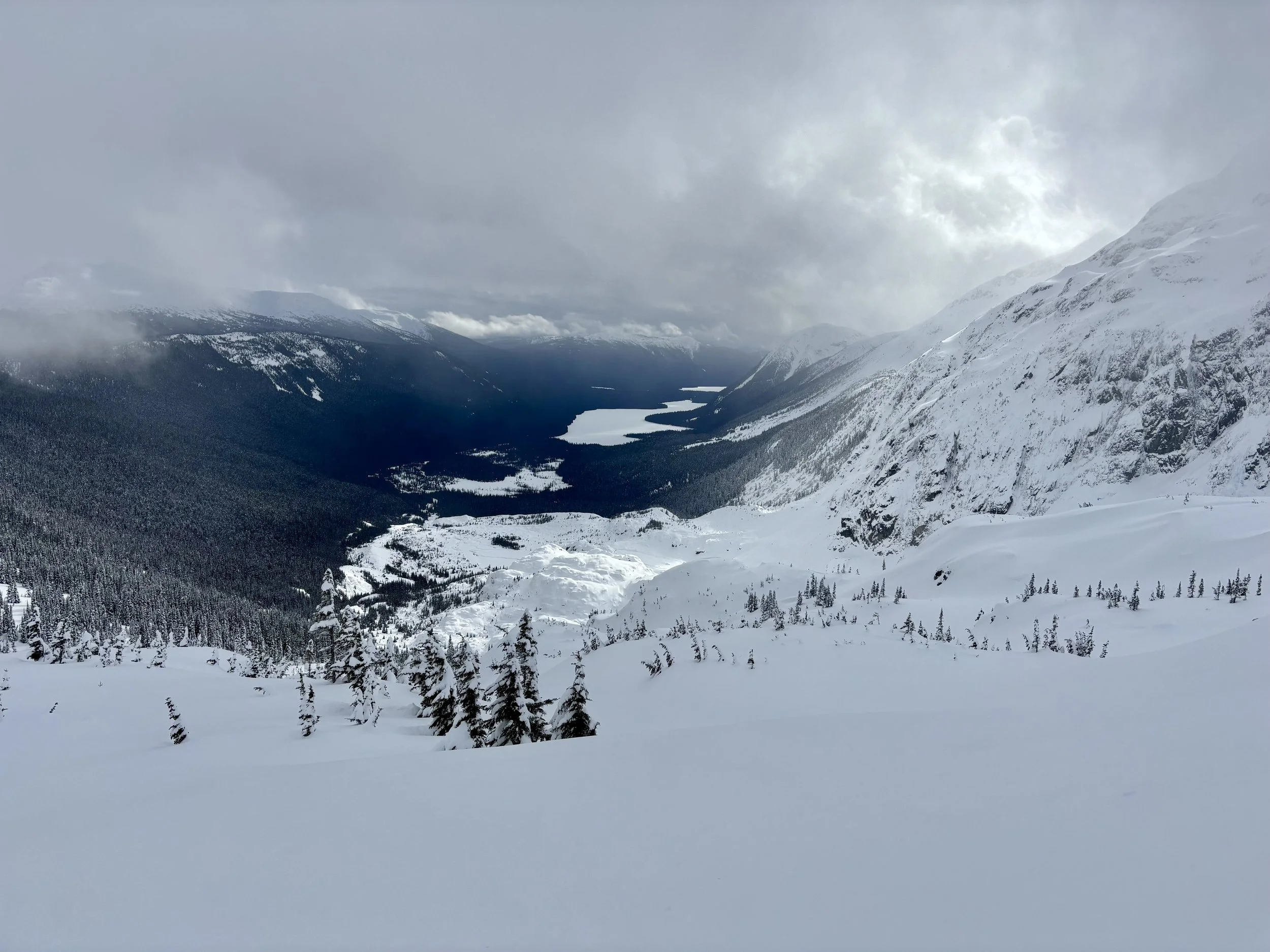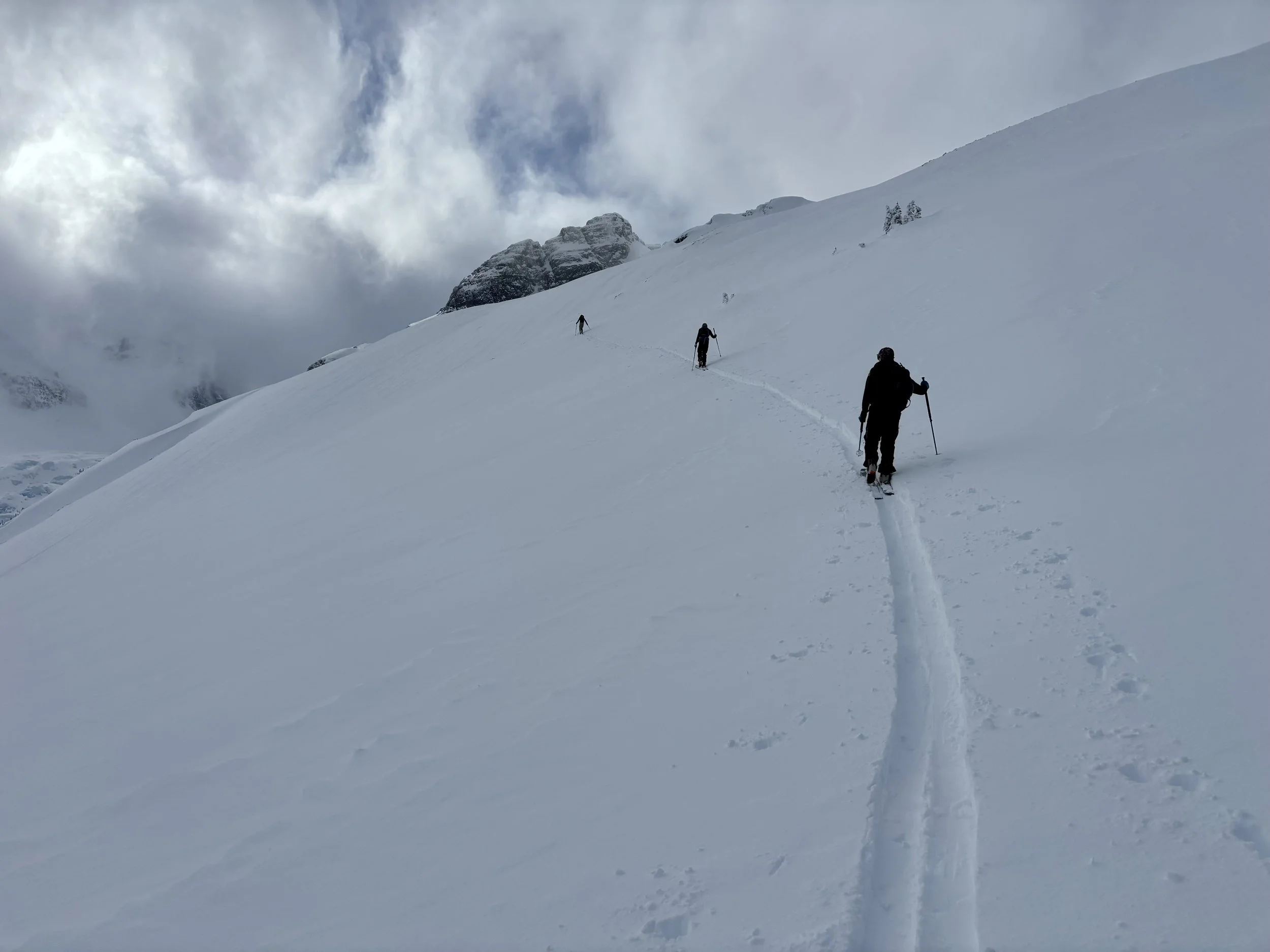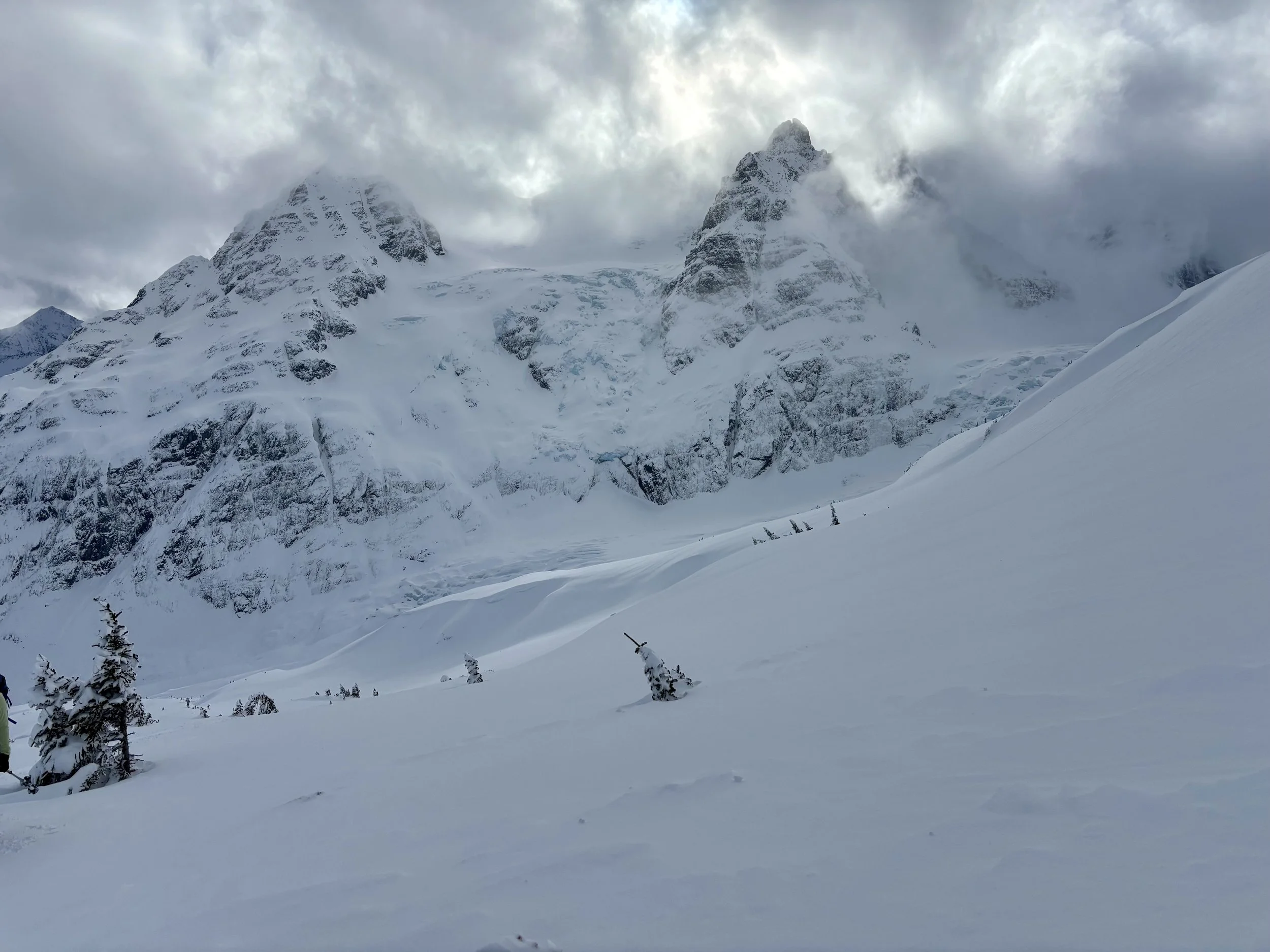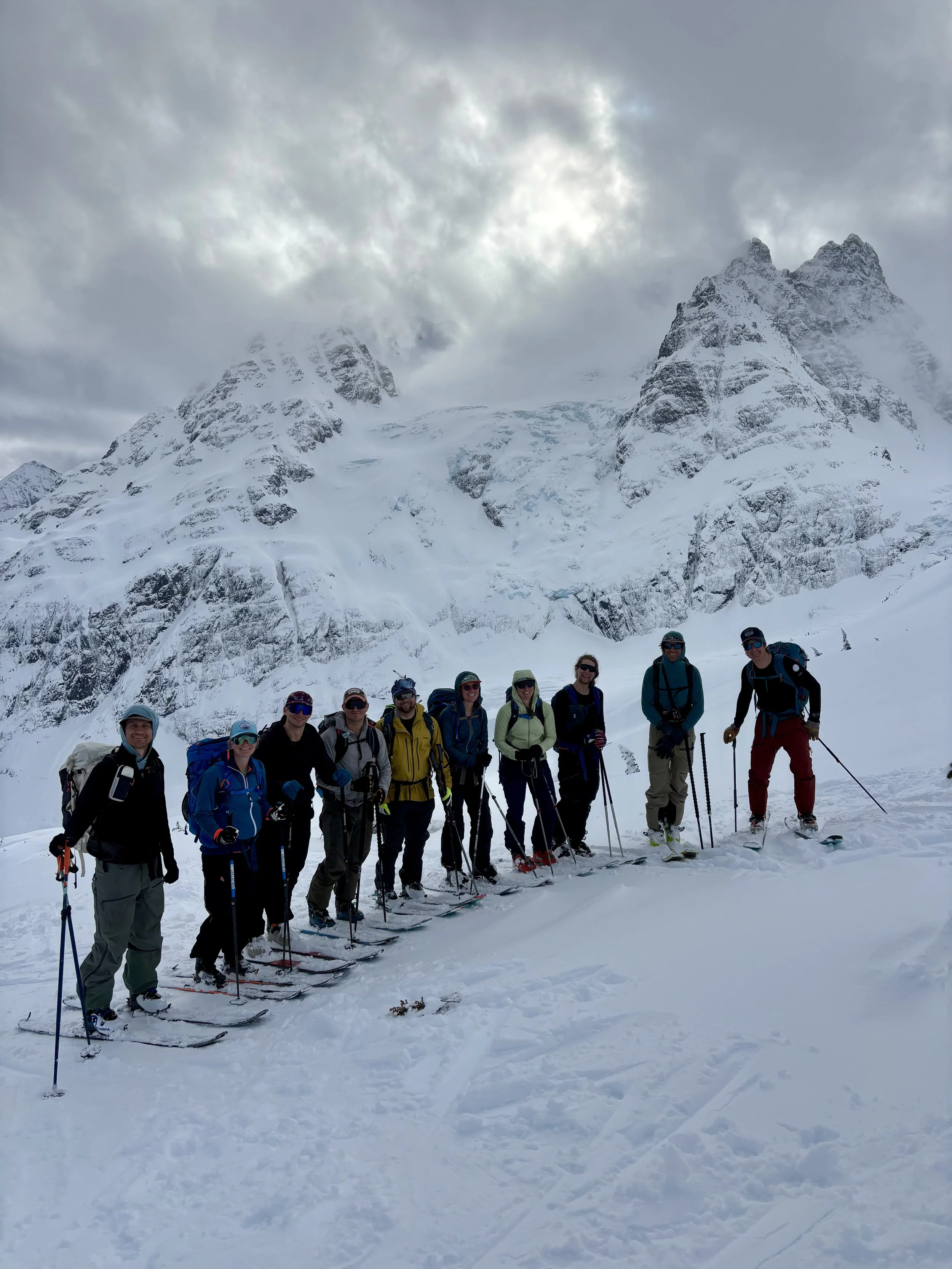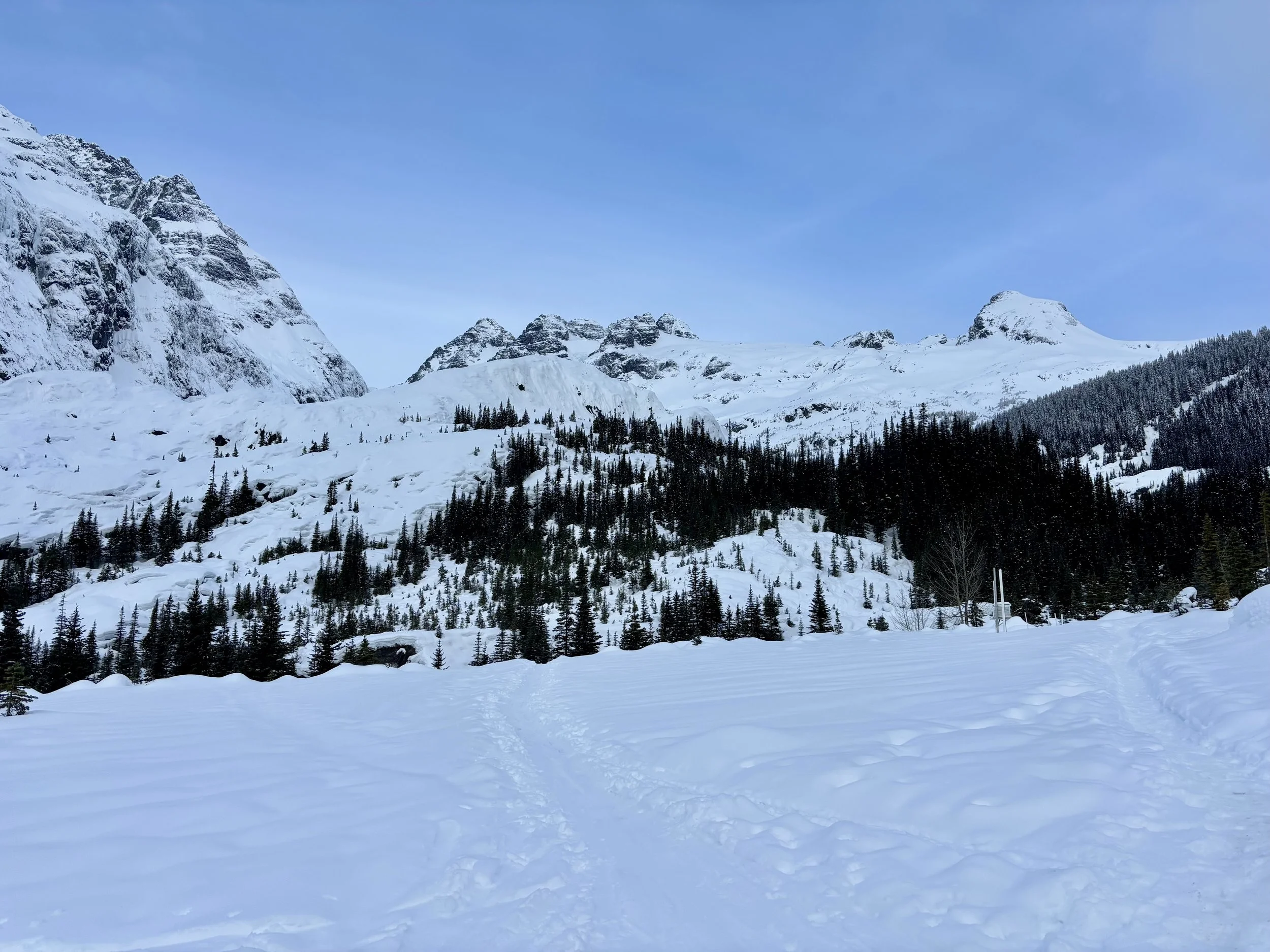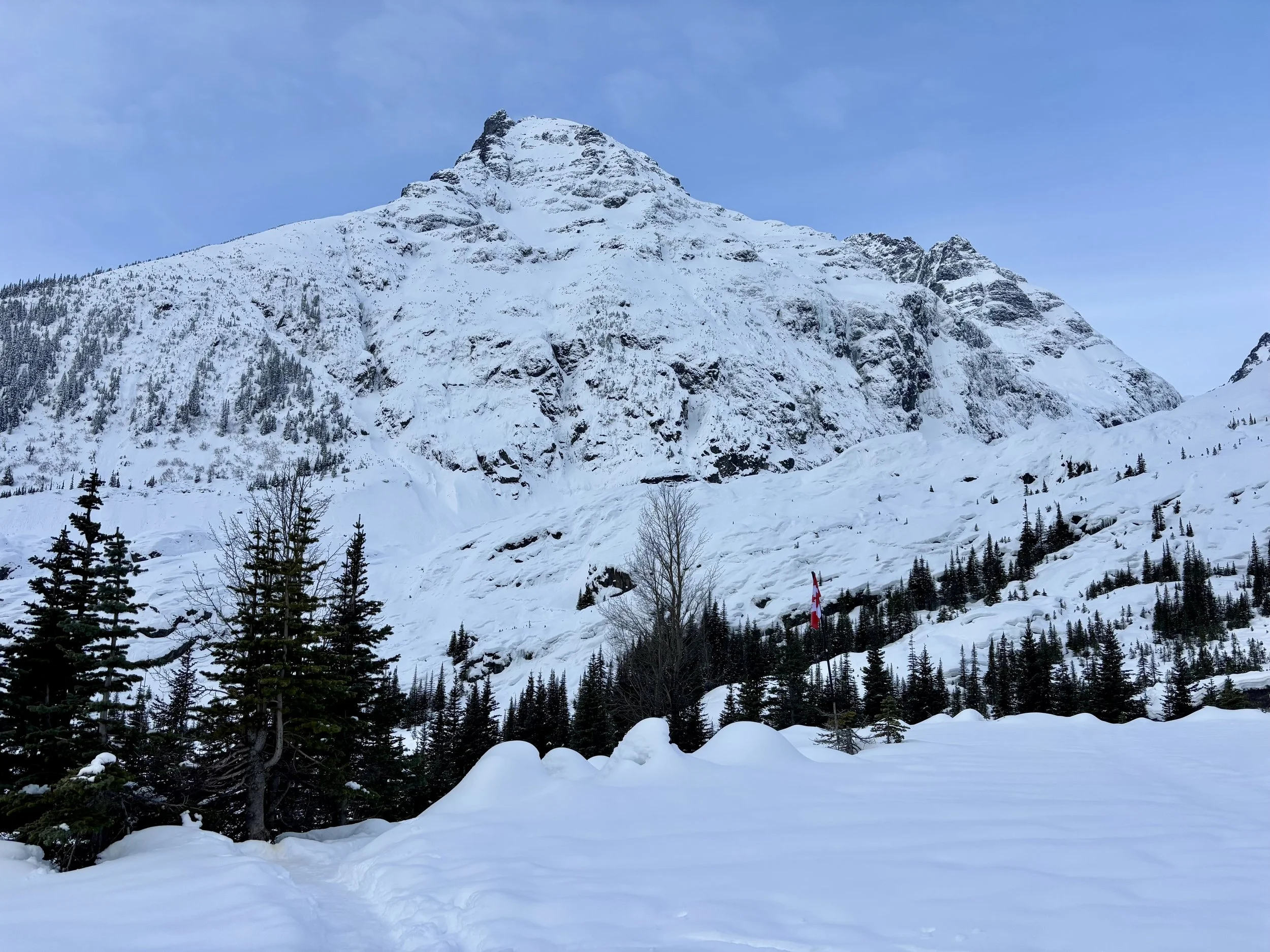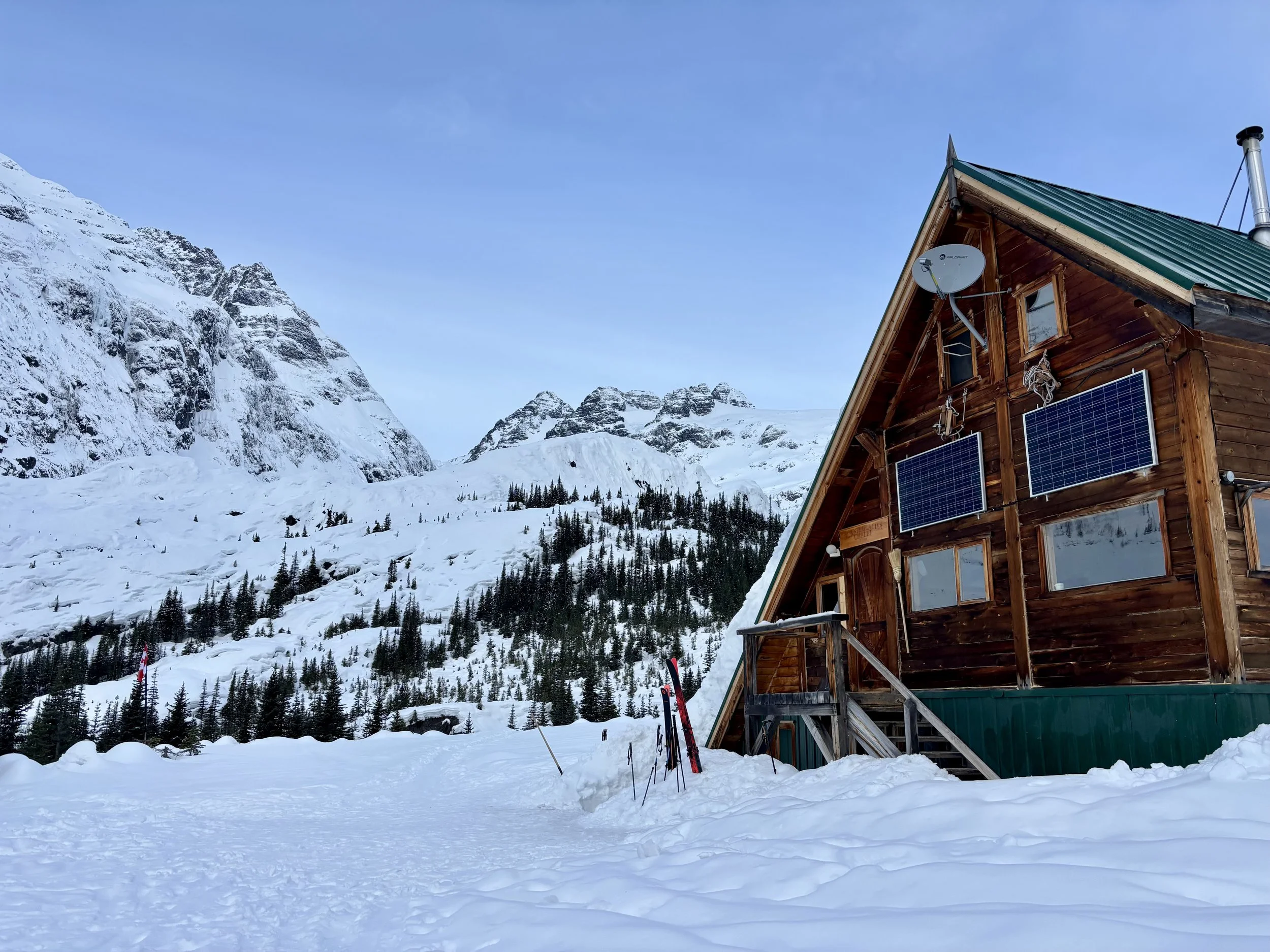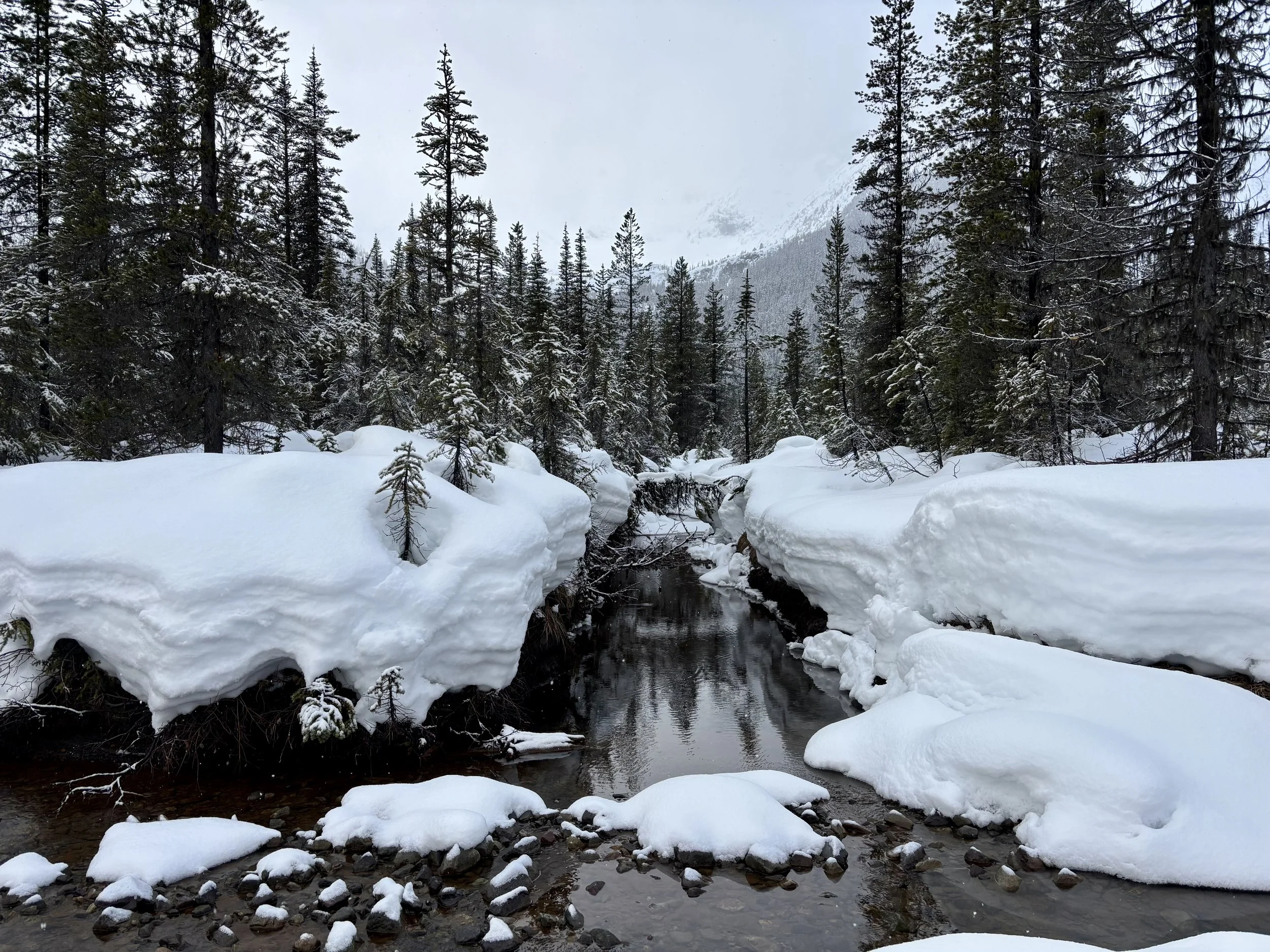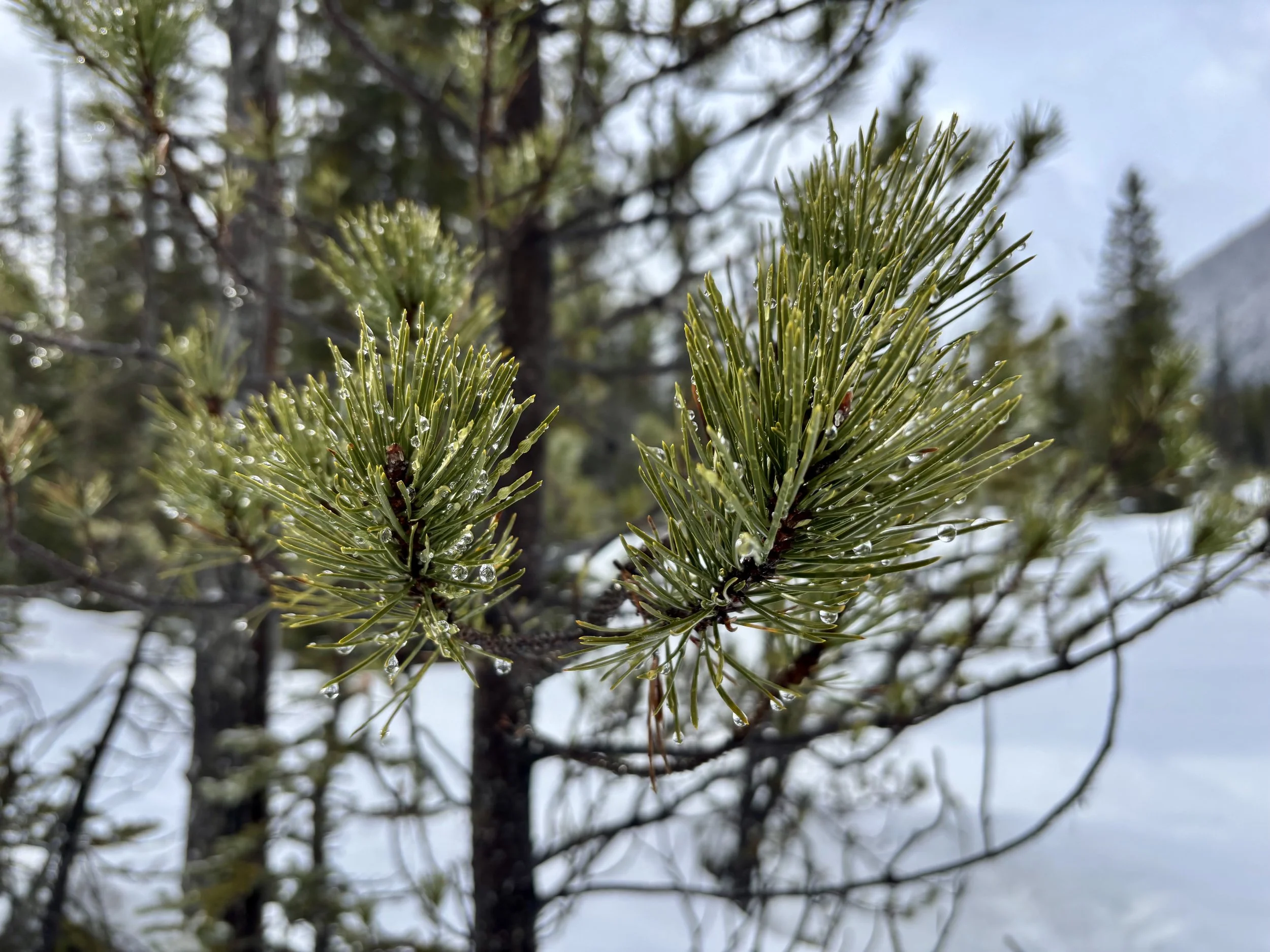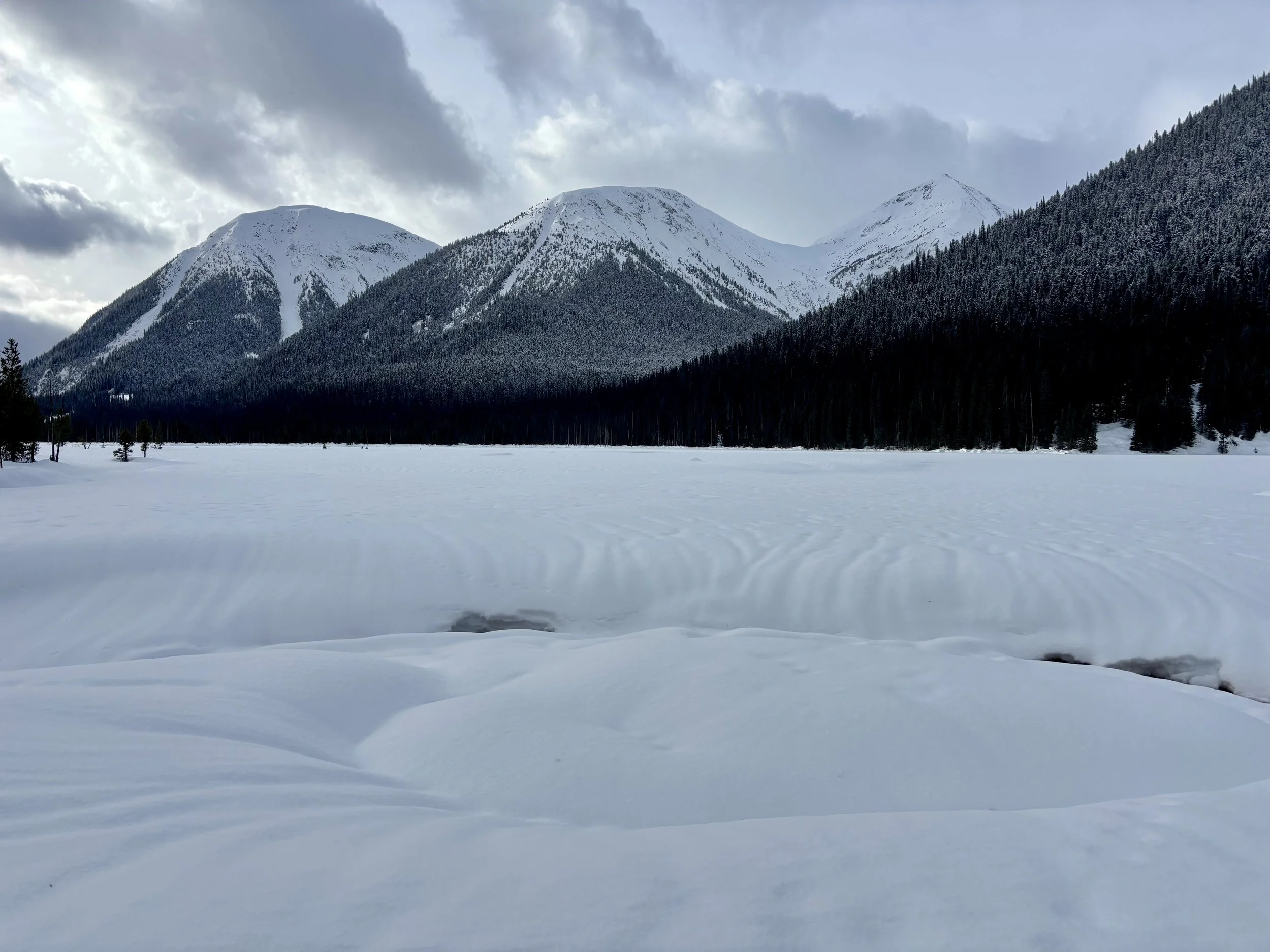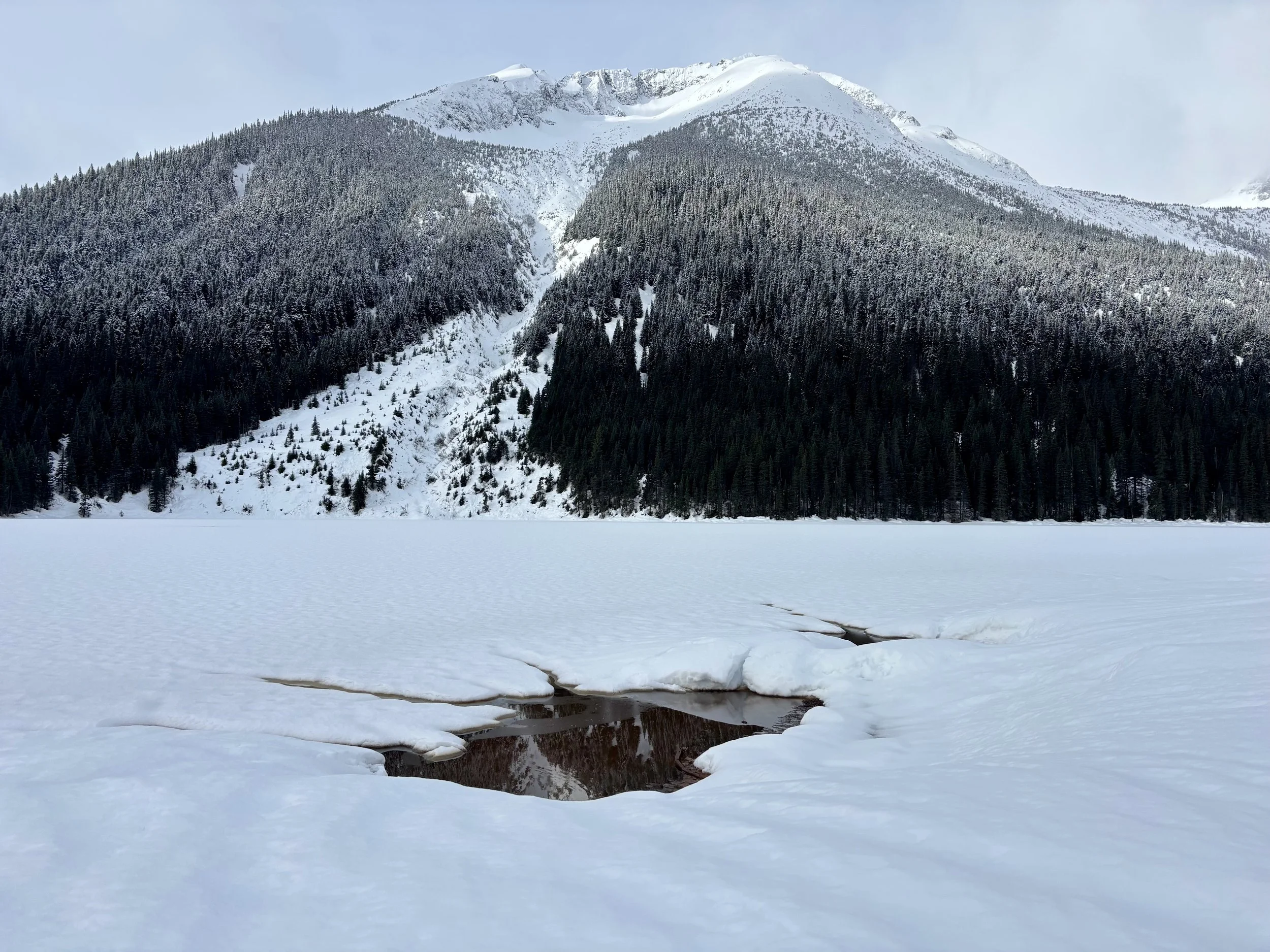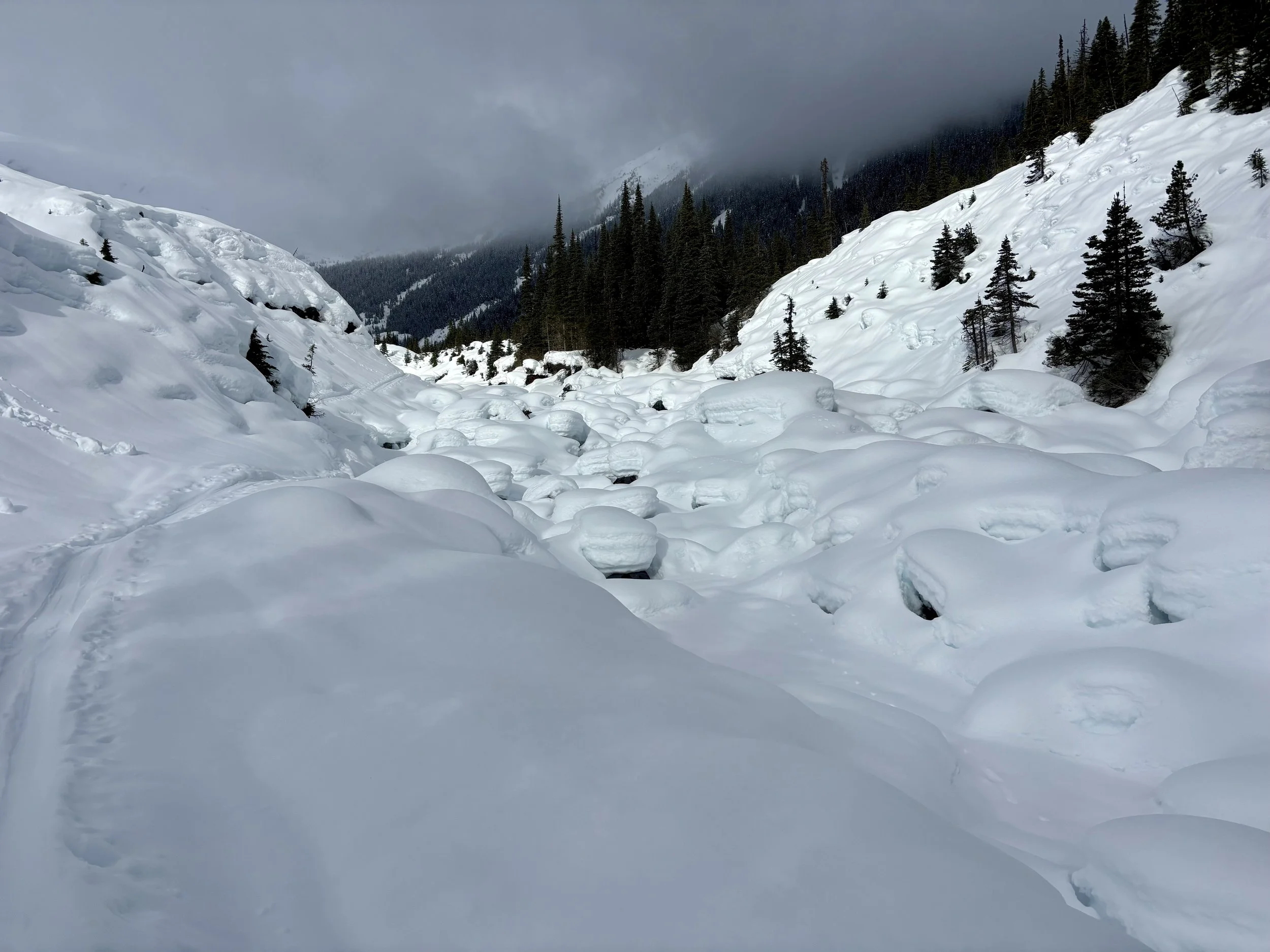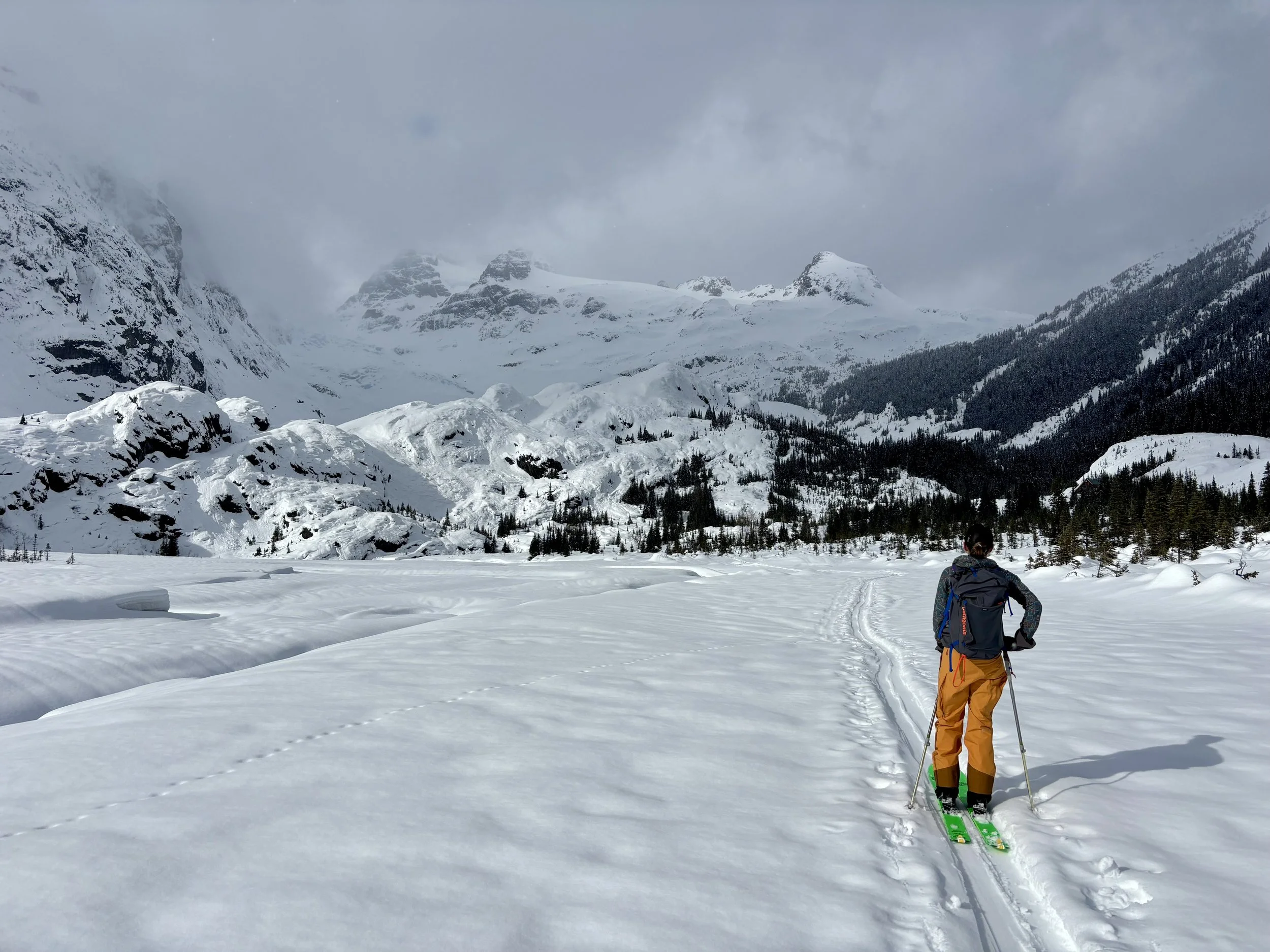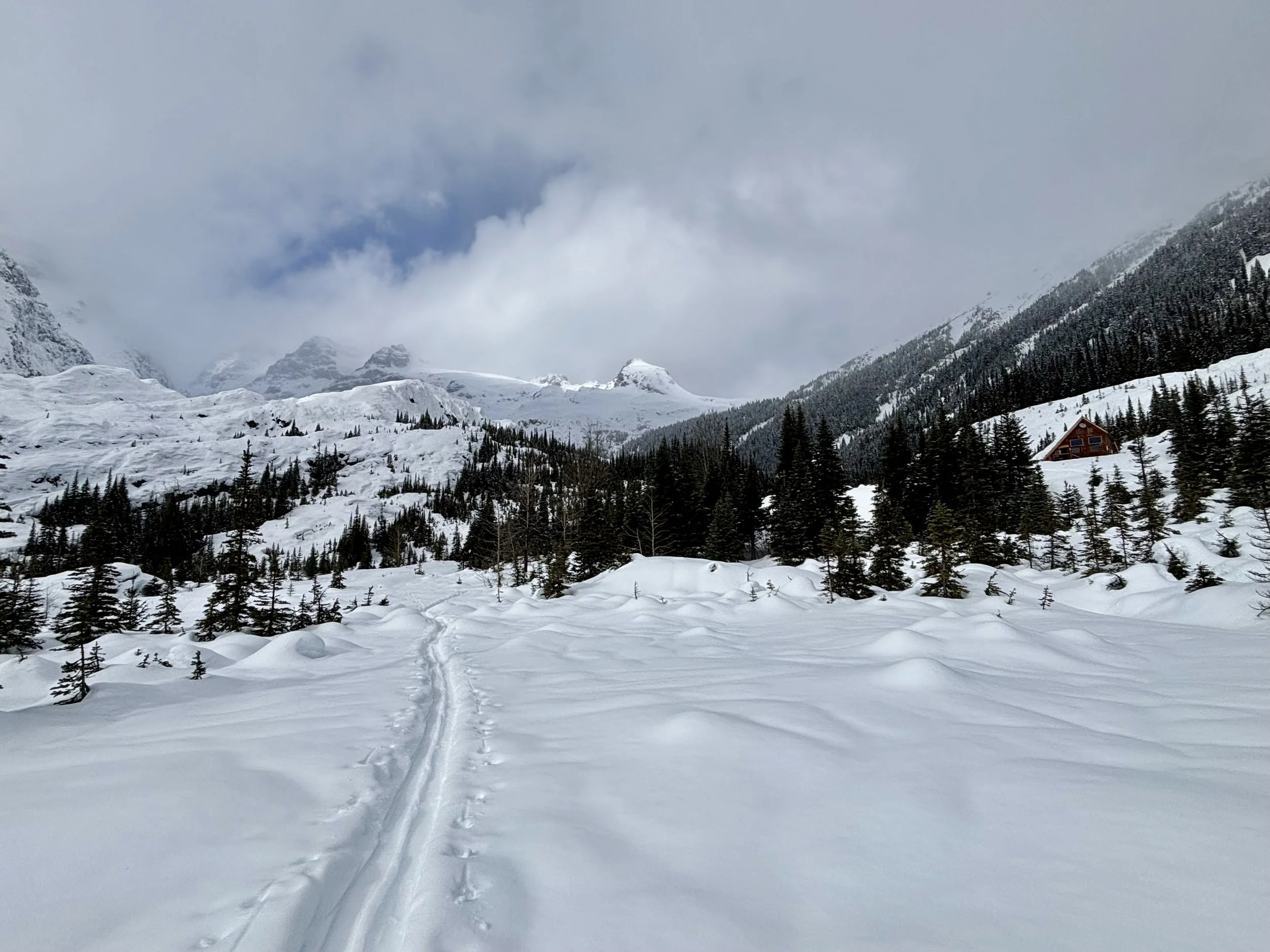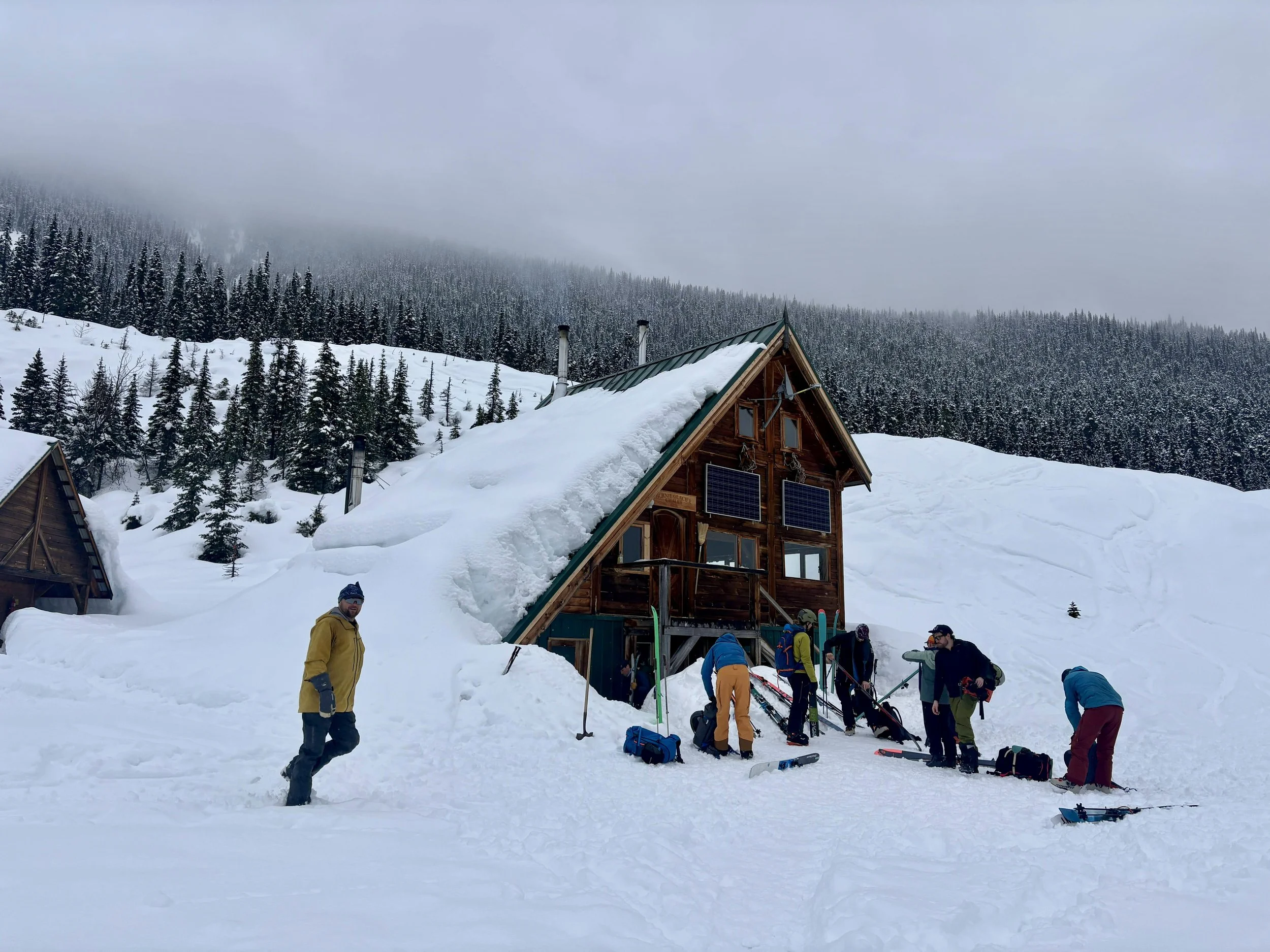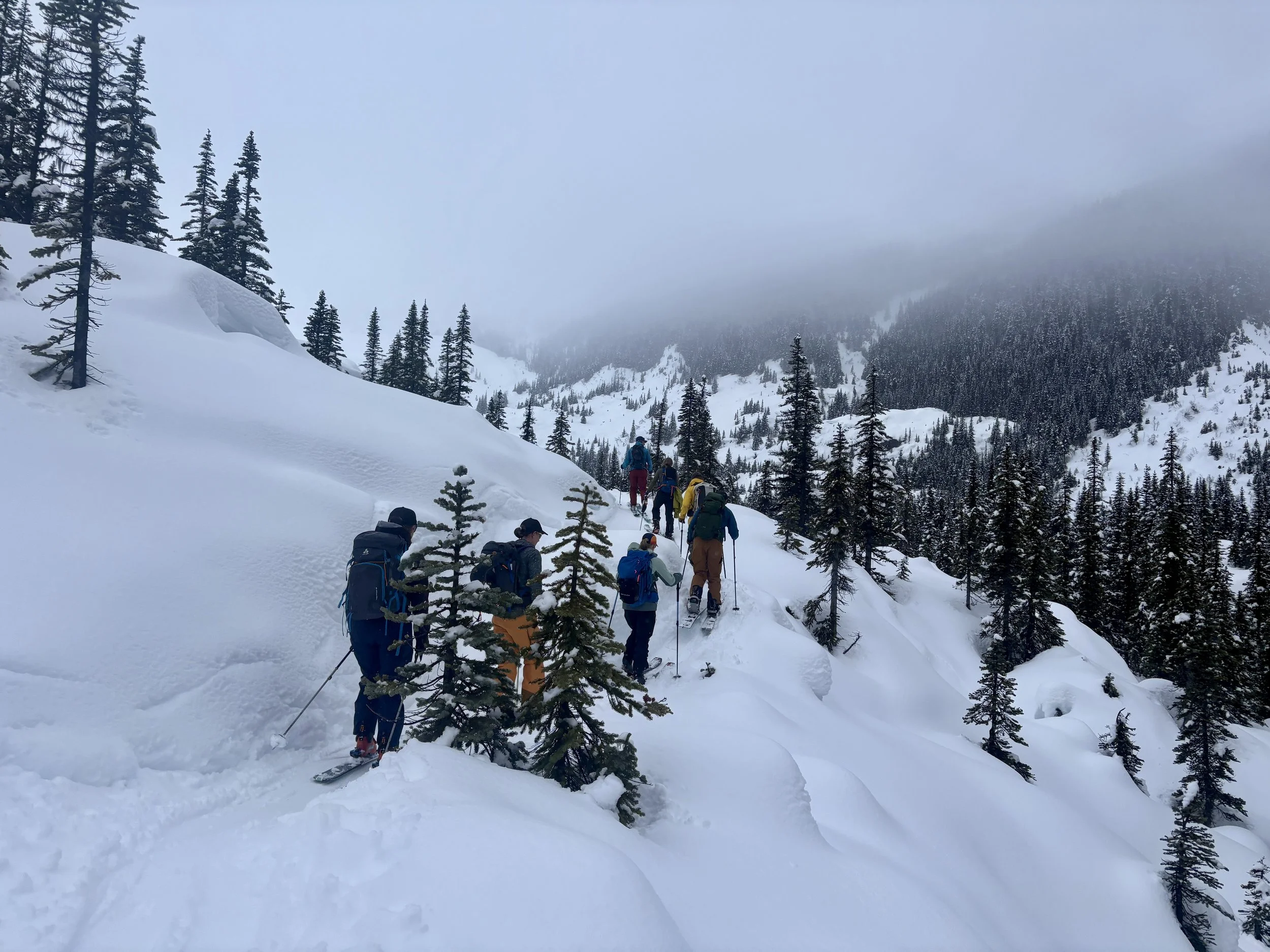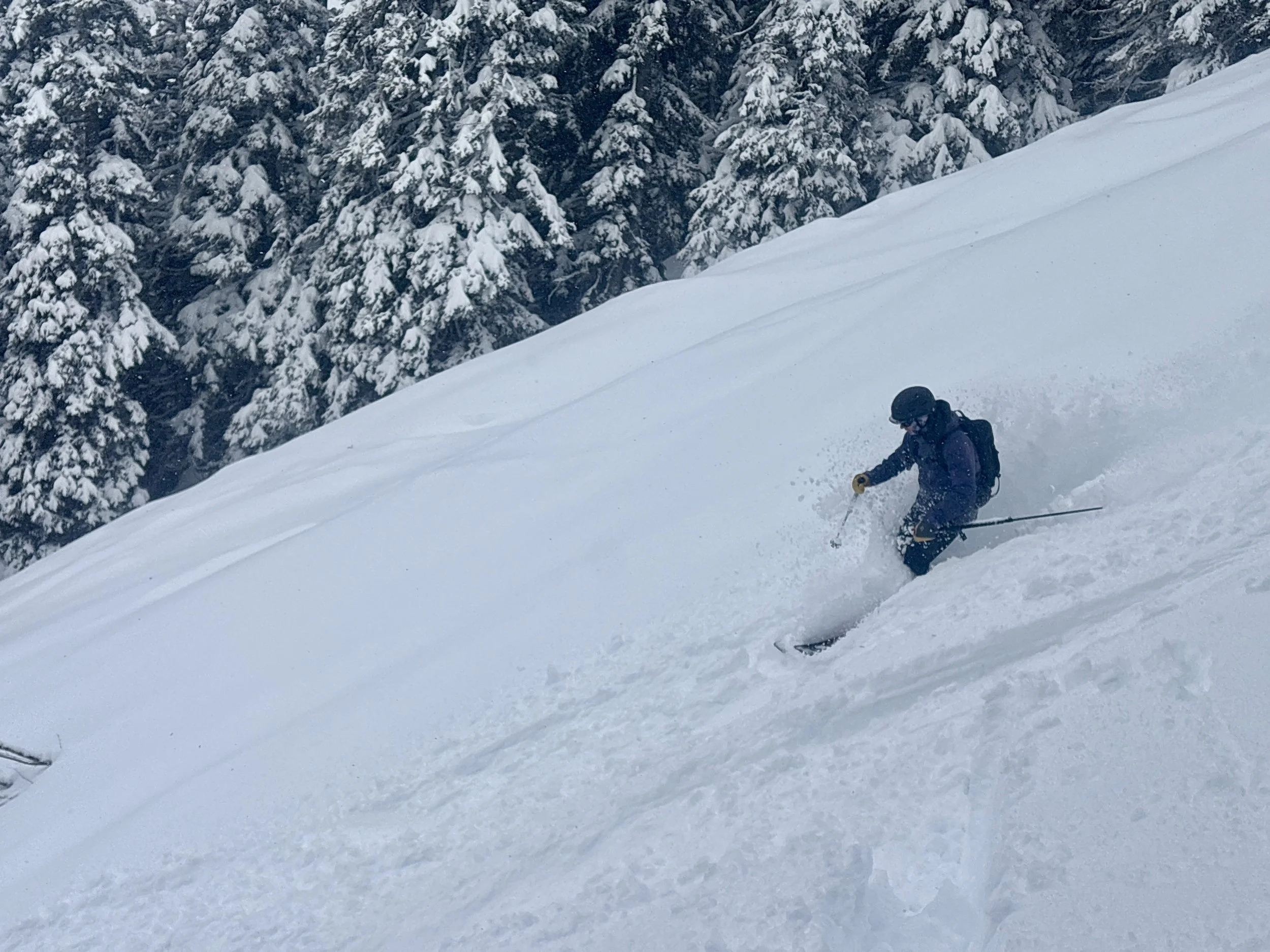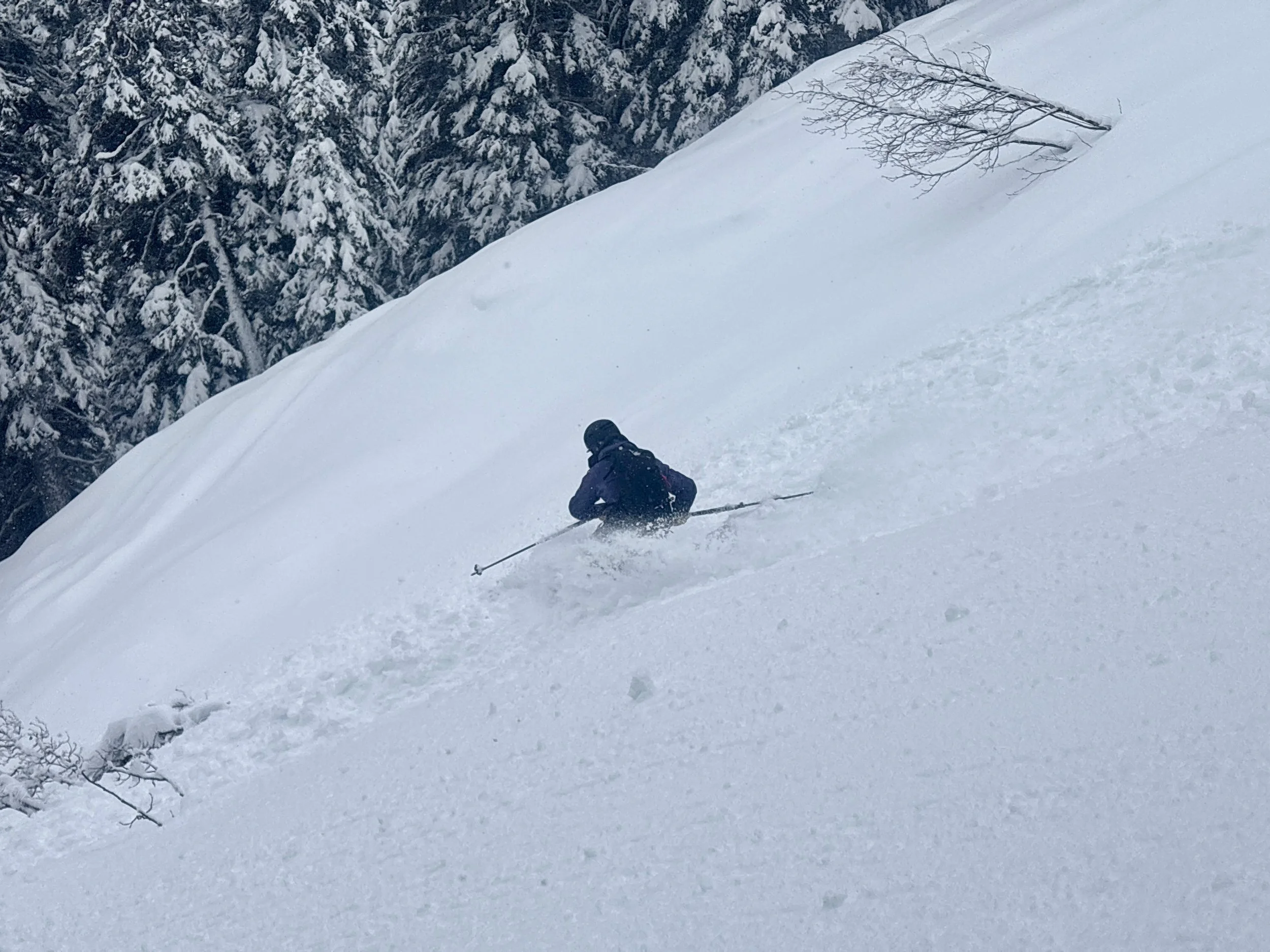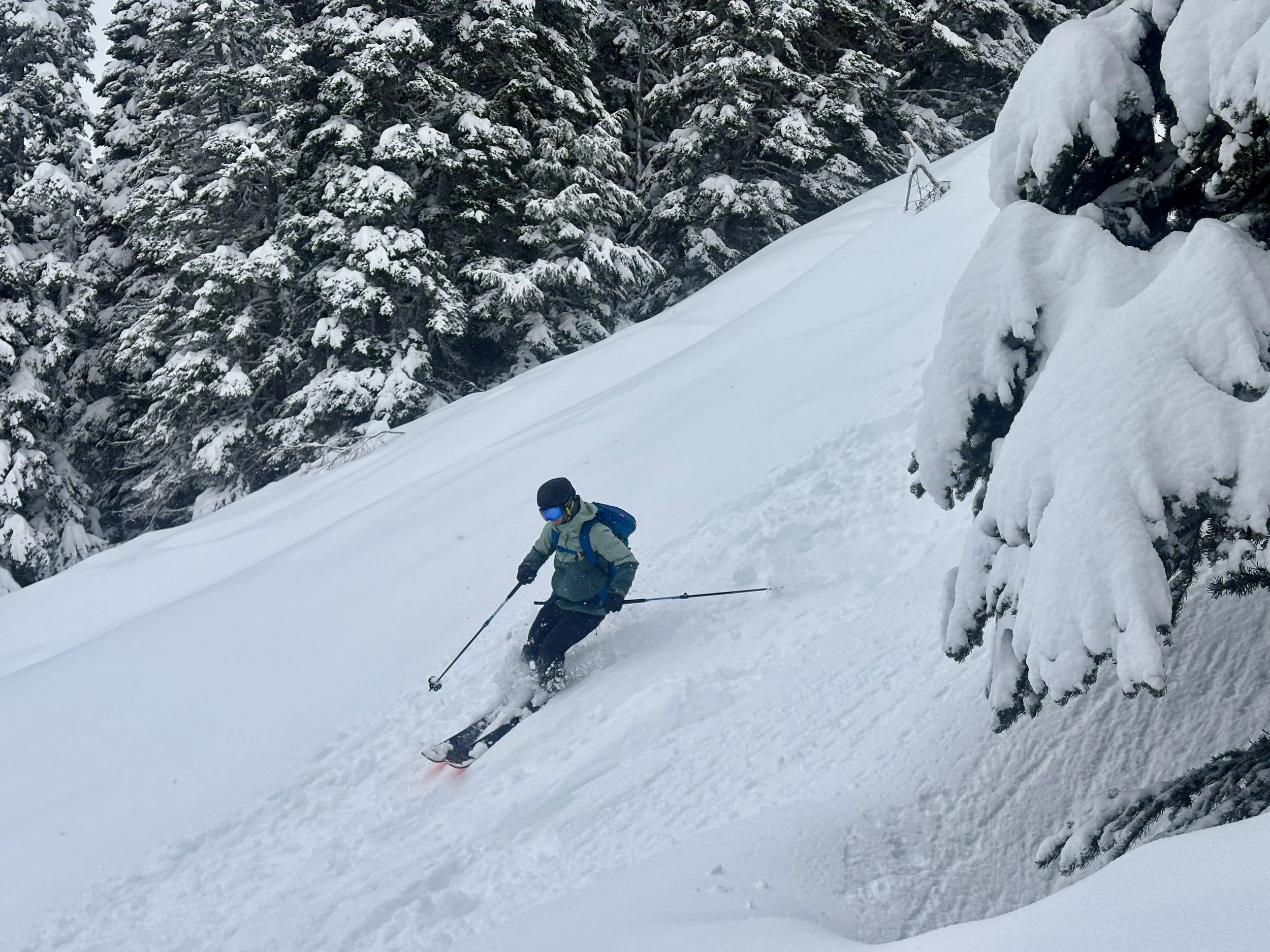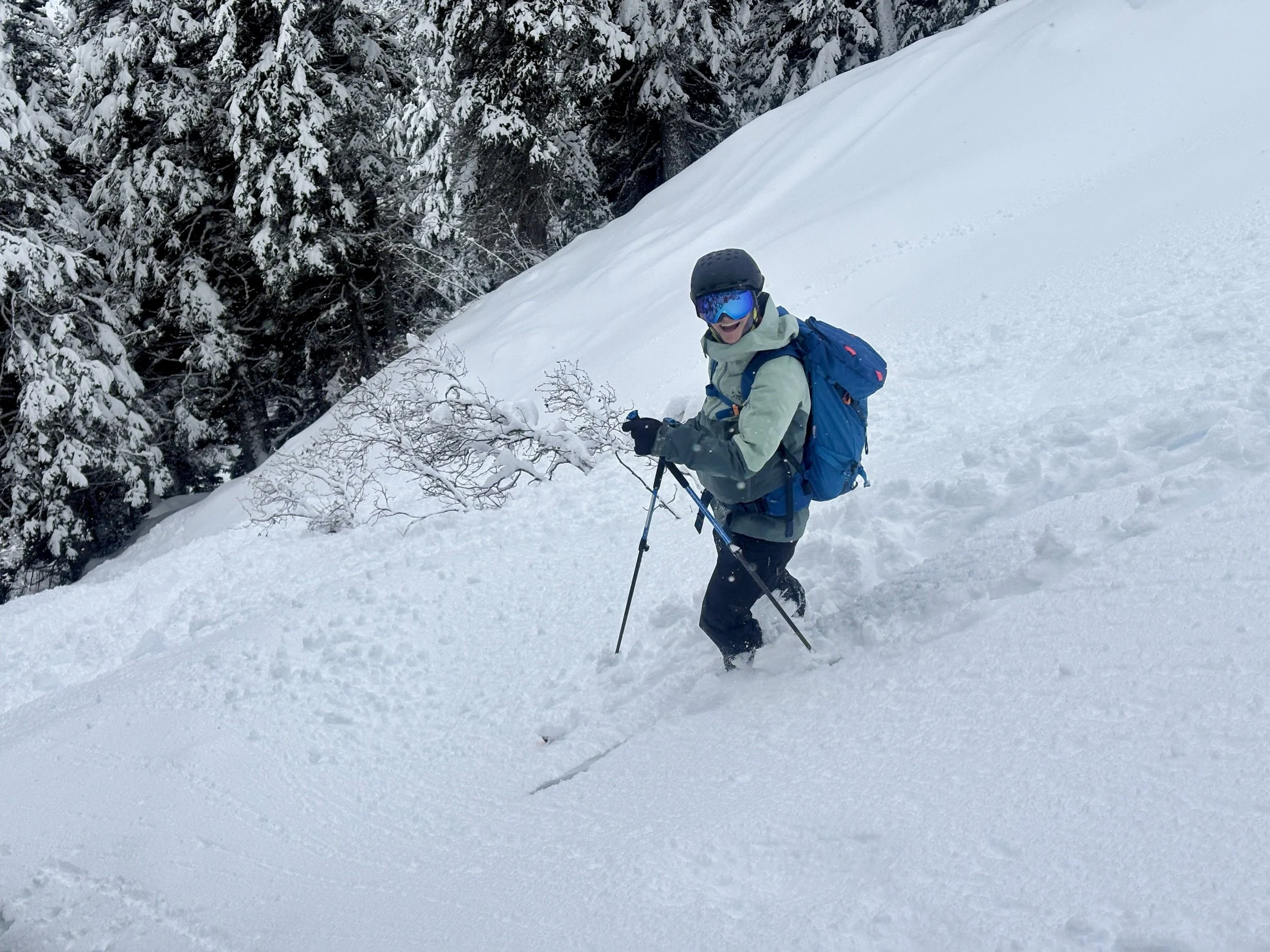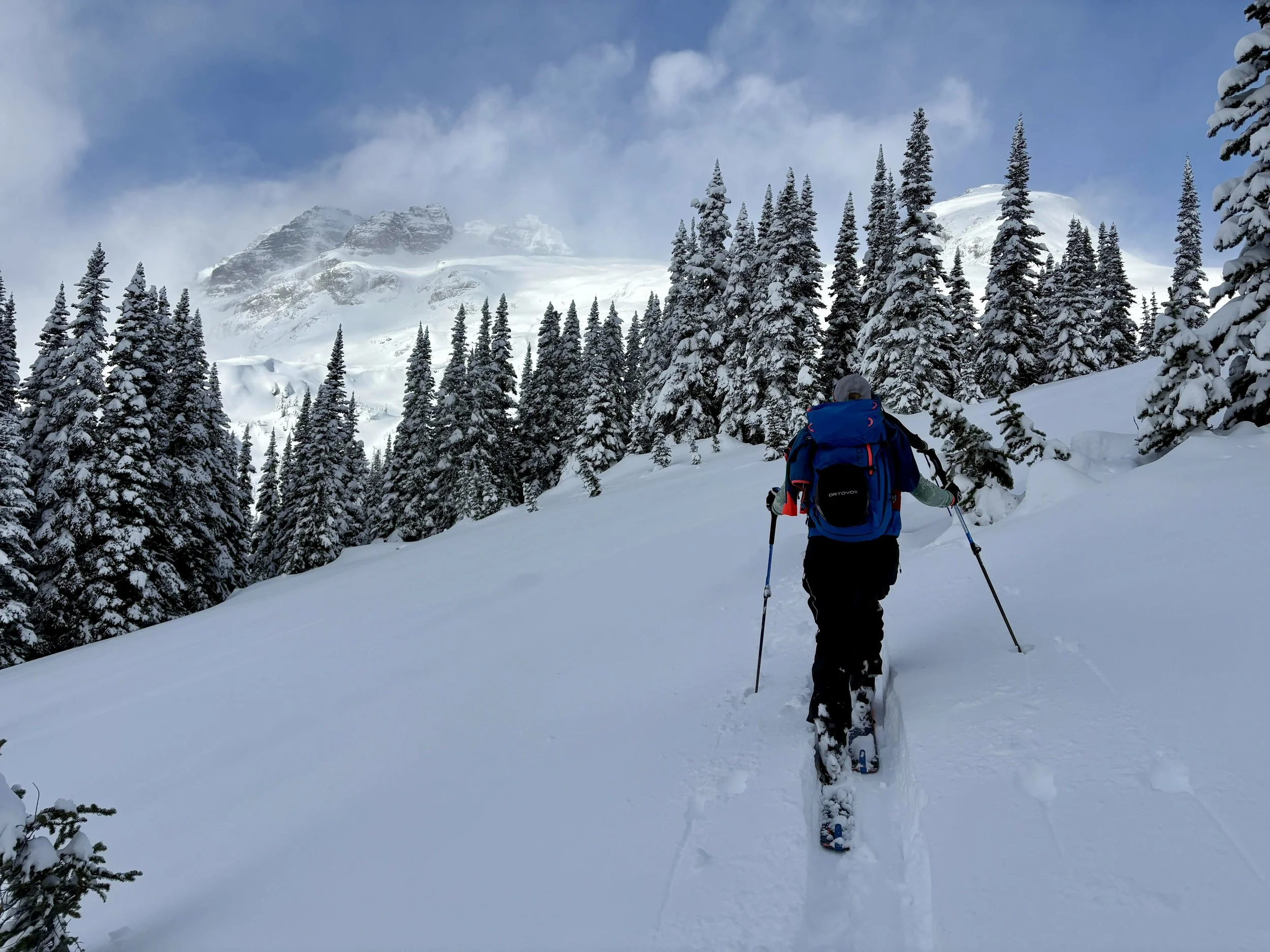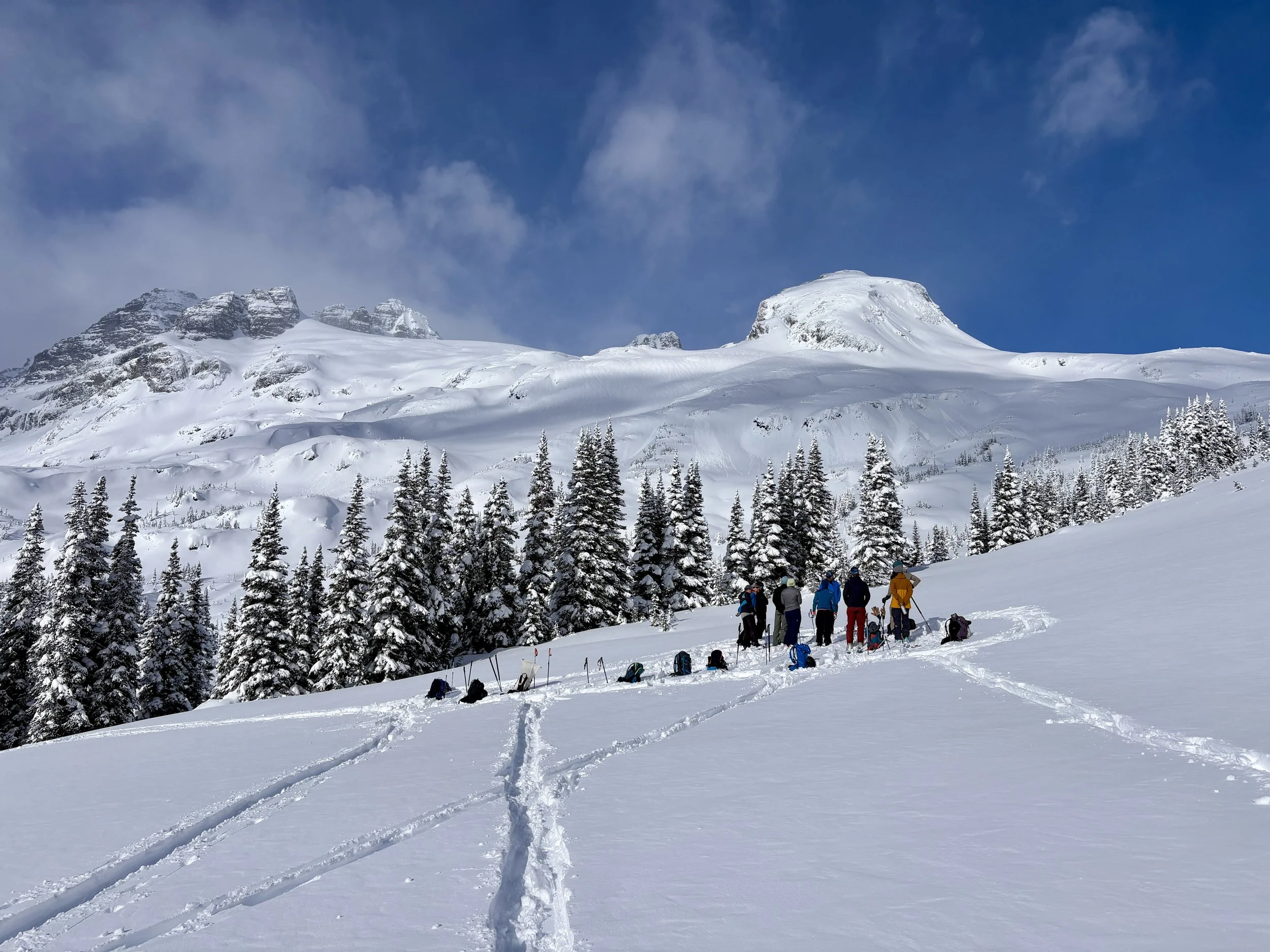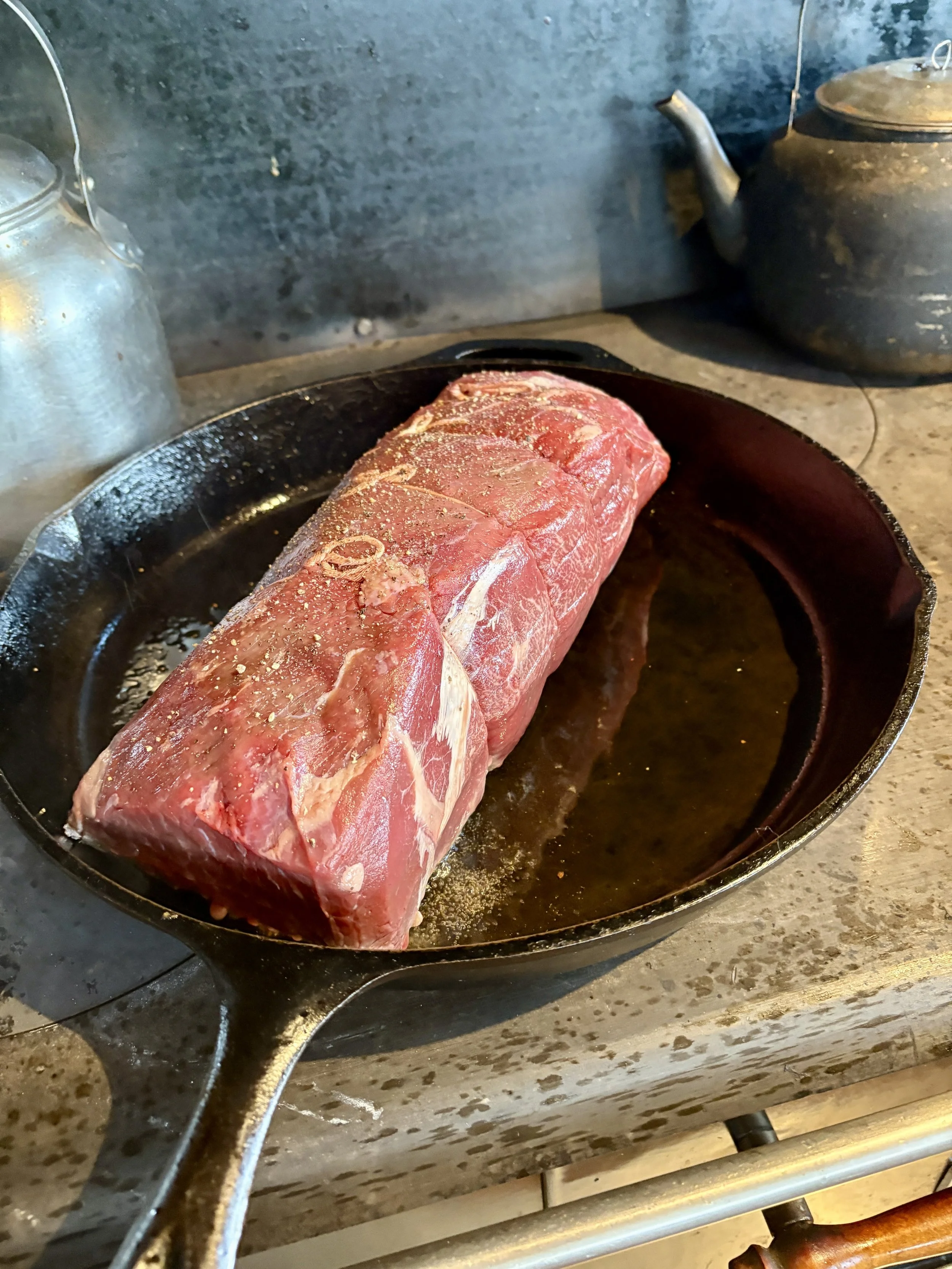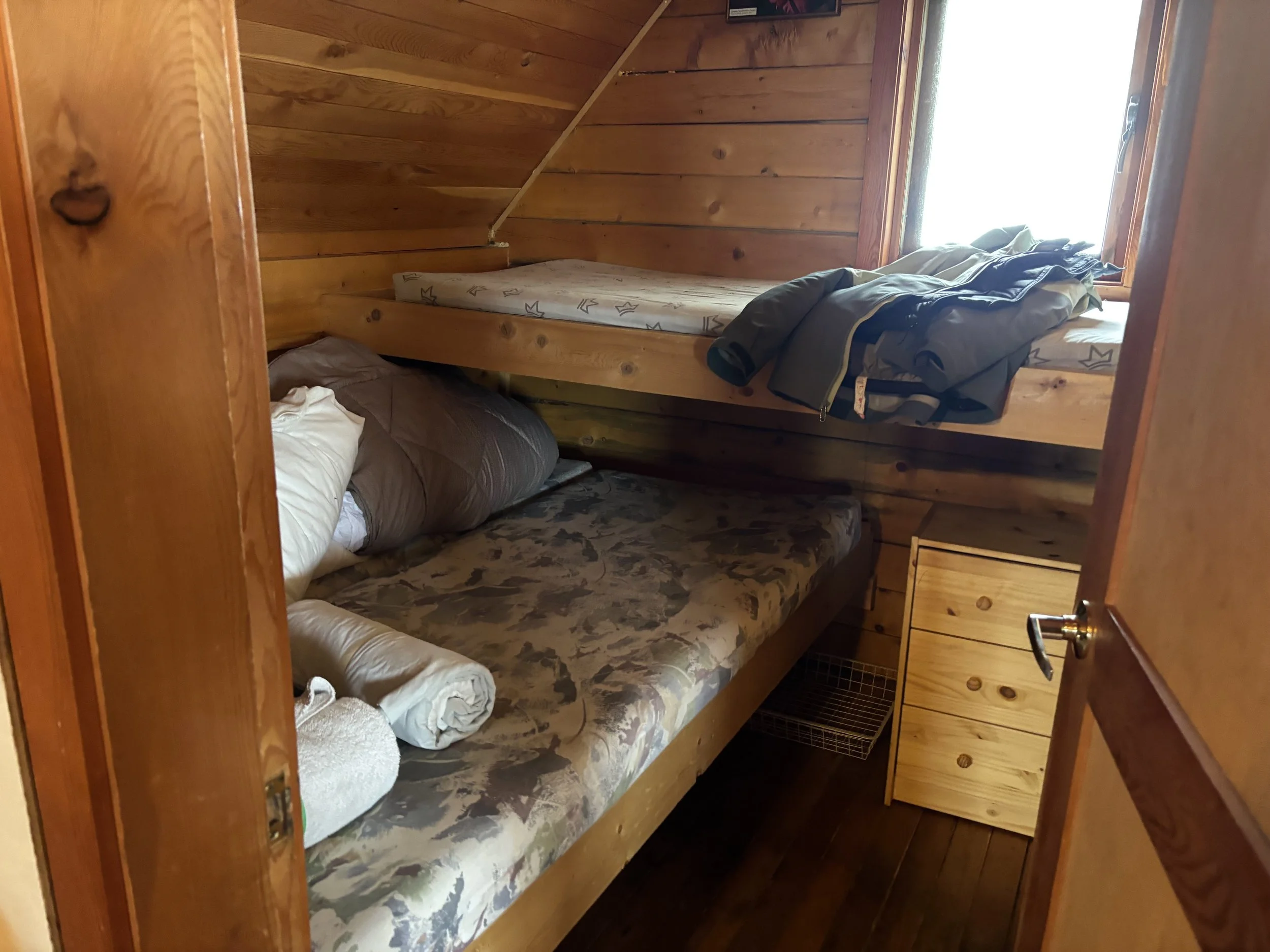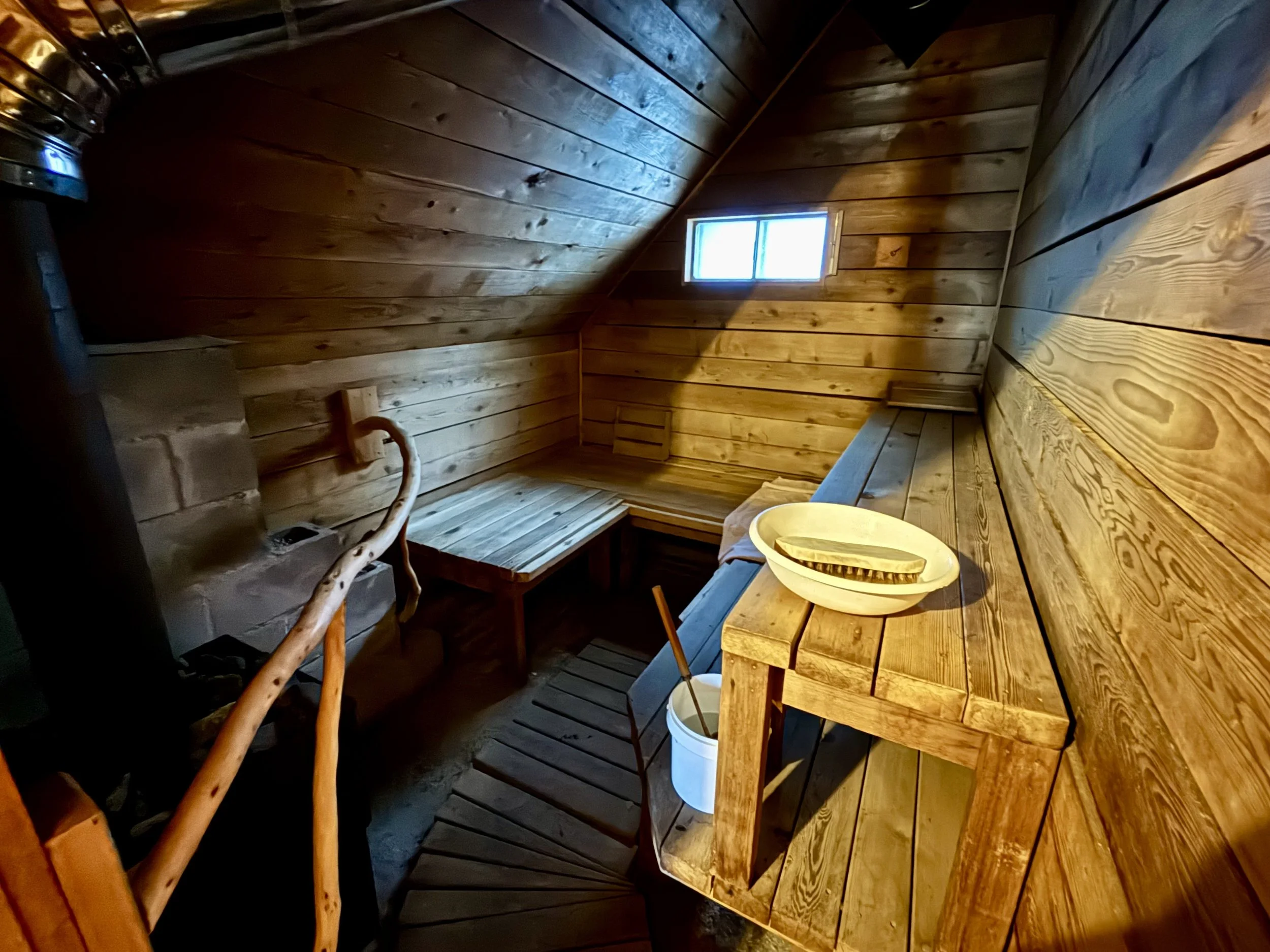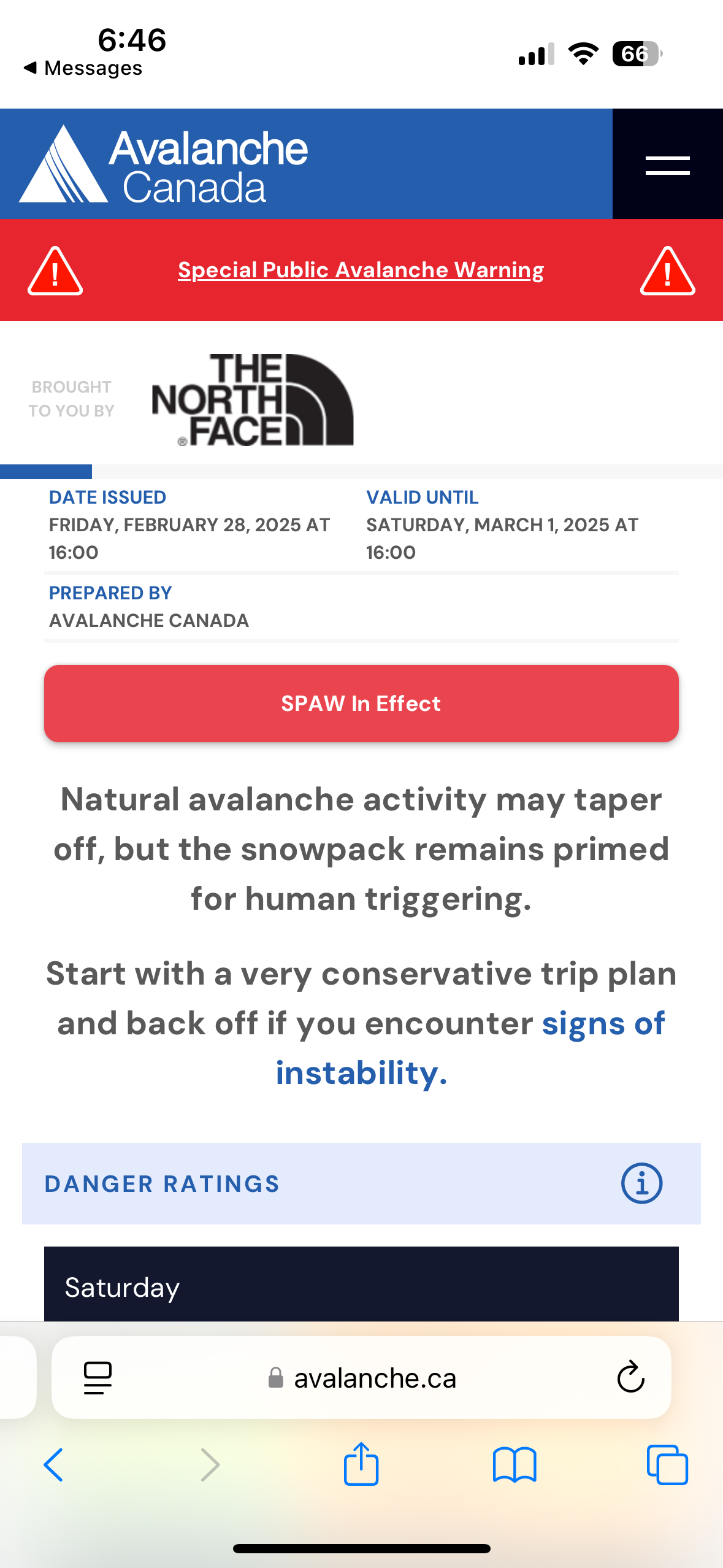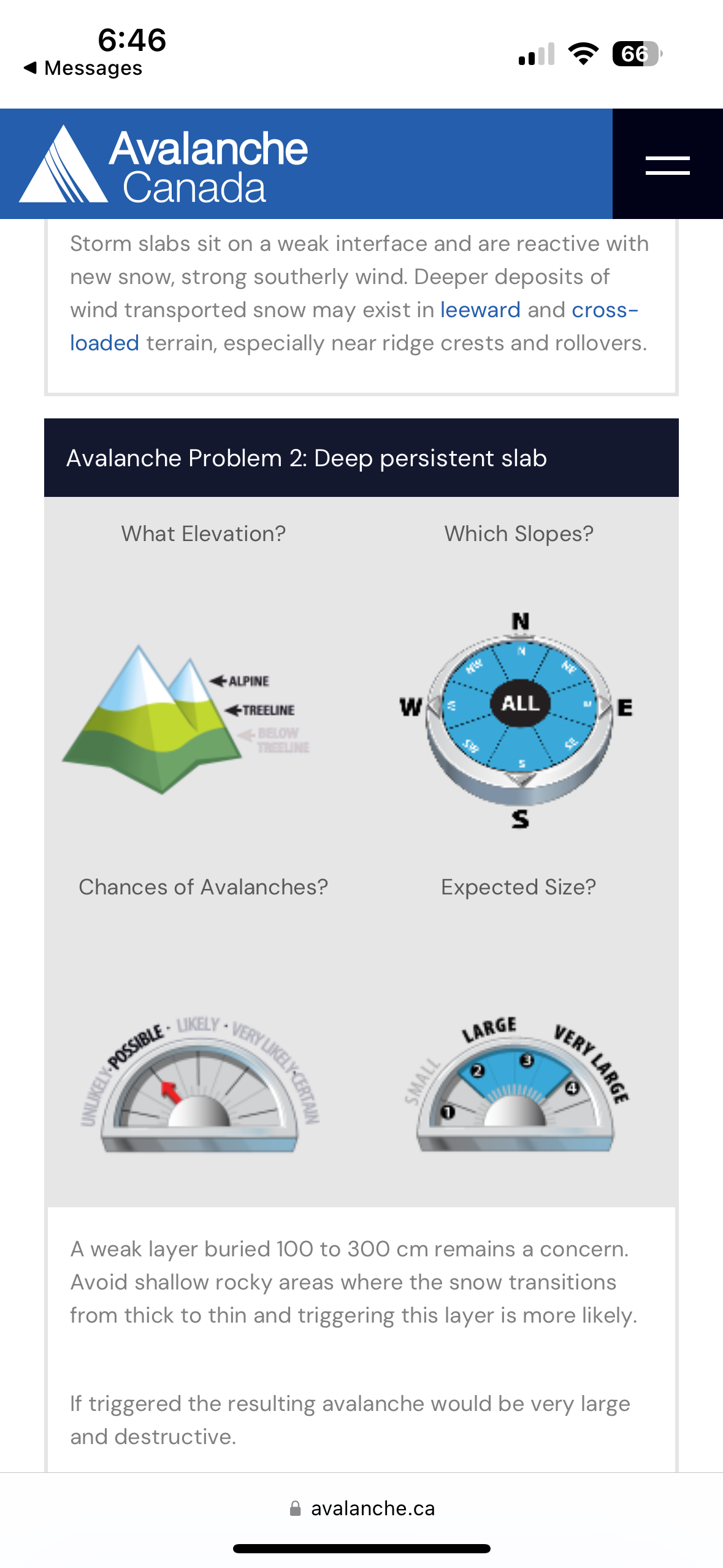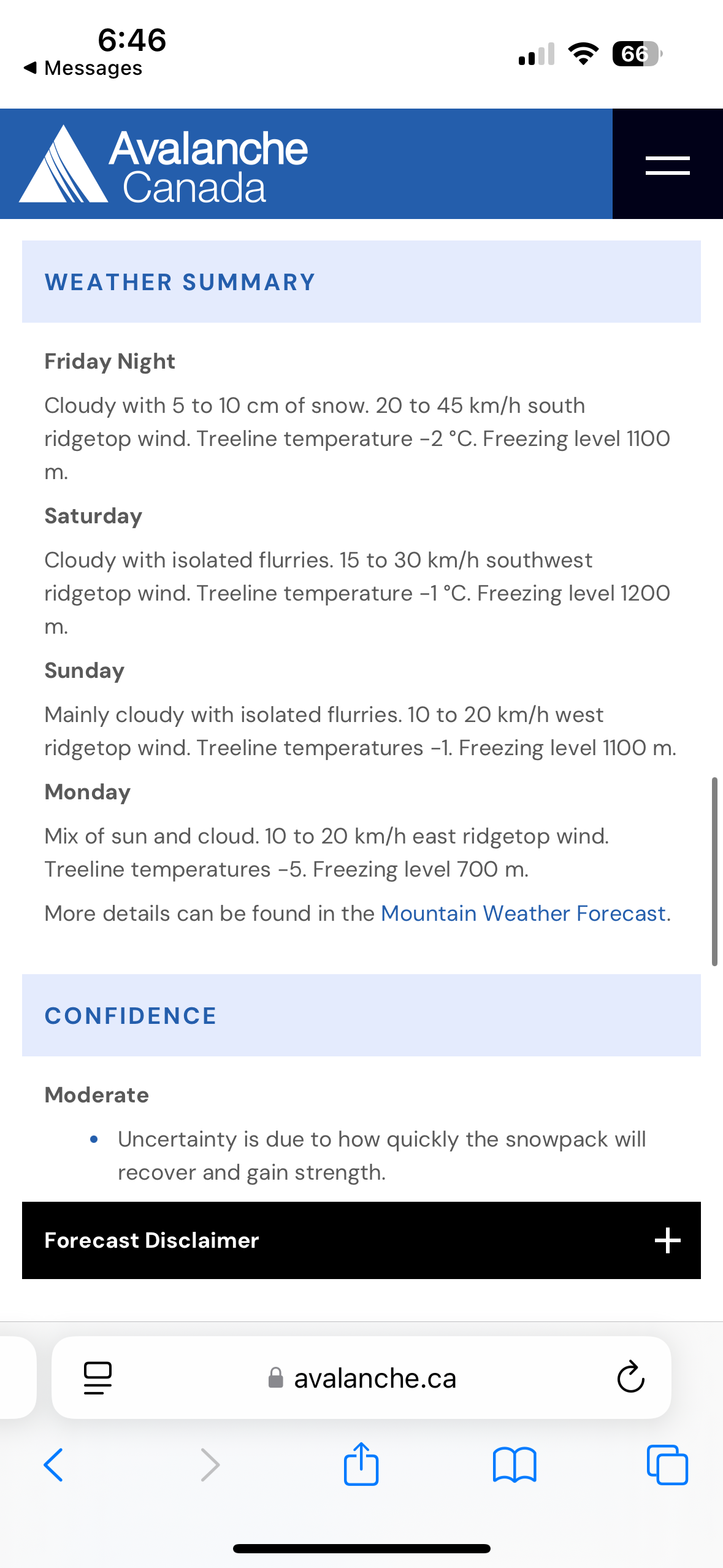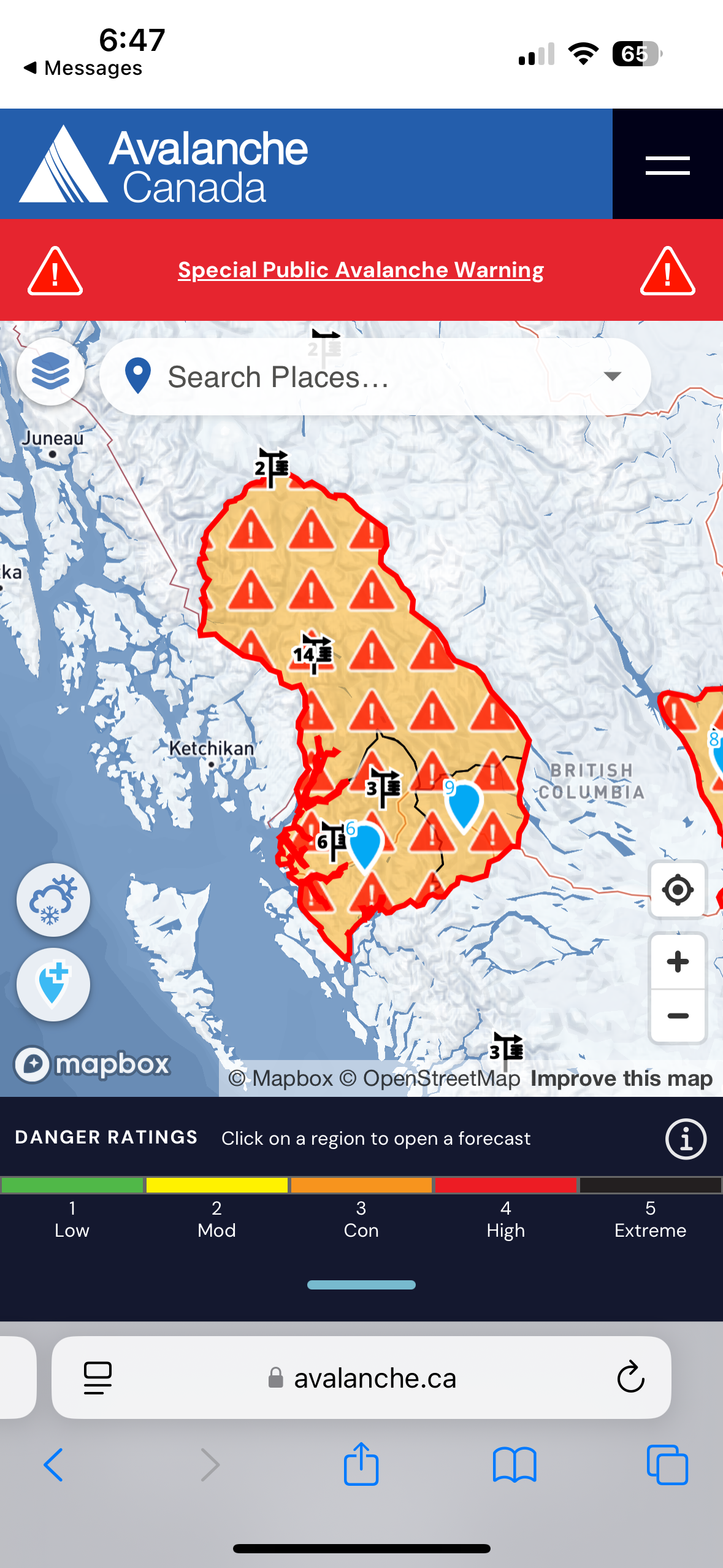Burnie Glacier Chalet Ski Trip, Smithers, British Columbia, Canada
Sunrise one morning as seen from the hut
After our Mica Heli trip ended, Mike and I had about 36 hours to drive 15 hours from Mica Creek to Smithers in northwestern British Columbia. Thankfully, the weather was mostly cooperative, and we made it to Smithers the night before our planned meeting time at the heliport. We spent that evening packing a new set of bags for this trip, and we were off to the Smithers heliport the next morning. The next thing we knew, we were in the helicopter heading to the Burnie Glacier Chalet, which would turn out to be on of the most difficult ski trips I have been on.
To set the stage for the trip, the Burnie Glacier Chalet is located outside of Smithers, BC. The only practical way to get there in the winter is via helicopter. We had friends who invited us on this trip and put together the group. The group consisted of 10 skiers from Colorado, but not everyone had skied together or in some situations even met before. When we got to the lodge, we were informed that one of the guests from the previous week (that no one in our group knew) would be staying and joining our group. The lead guide for the trip was Conor Hurley, who owns Arctos Guides. I’d like to mention that Conor had rented the lodge from the owners of Burnie Glacier Chalet and was operating independently of the owners of Burnie. He had no affiliation with them and all of his decision making was his own and not reflective of what another guide or the owners of the lodge would do. The tail guide was Dave Stimson, a lead guide at Last Frontier Heli. I am calling Dave the tail guide because he wasn’t the guide we booked the trip through, however, Dave did tell Mike that he wasn’t a tail guide and that both him and Conor were co-guiding. There was also a practicum on the trip whose job that winter was to work in the field with AvCan Northwest. In total, this made for a group of 14 (11 guests, 2 guides, 1 practicum). The snowpack that season was uncharacteristically unstable for the region. The area had been battling a persistent slab problem all season. None of the guides had been to Burnie at all that year and the only one who had really skied in the region that season was the practicum. All of the guides were flying in at the same time as us so they didn’t have more knowledge about the snowpack than we did. Upon arrival or at any point during the trip, I never heard of or saw the guides dig a snow pit or do anything to assess the snowpack in a more thorough manner than I did. Going in to the hut, the avalanche danger rating from Avalanche Canada was 4 (high ATL), 4 (high NTL), 3 (considerable BTL) for our first full day. The avalanche problems were storm slab, persistent slab, and wet loose. After departing the Smithers’ heliport, guests did not have access to internet so we were not able to check Avalanche Canada for updates and had to rely on what our guides were telling us.
Let’s get back to the trip.
The afternoon of the arrival day we headed out as a group for our first, short tour of the area. It was snowing and the freezing line was right about at the level of the hut, which made for some heavy snow. After a short, wet lap we went back to the hut to finish unpacking and settle in.
The following morning we woke up to some fresh snow and low visibility. After breakfast (which was delicious - all of the food was) we packed up our lunches and bags and headed out for a full day of touring. We headed out on the skin track that heads up towards Solitaire Pass and Tom George Mountain. Because of poor visibility, we stuck to the trees on Tom George that day and did a few laps there. After our third lap, I was quite cold and wet from the snow and decided to call it a day. On our way back to the hut, the lead guide, Conor, ski cut and triggered an avalanche on a ~100 ft rollover. No one was caught, and we skied down the bed surface of the avalanche. This avalanche was not discussed at any point during the trip. Warm soup was waiting for us at the hut, which was one of my favorite parts of the day. We took a sauna before dinner (as we would end up doing most nights) and hung out for the rest of the night.
The next morning we woke up to a bunch of new snow around the hut and we knew there would be more snow to be found as we went up high. The guides gave an avalanche danger rating as 4 (high ATL), 3 (considerable NTL), 3 (considerable BTL) for the day. The plan for that day was to ski some different trees off of Tom George, these trees were farther east than the ones we had skied the day before. As we ascended, my prediction for a fair amount of snow was correct. We made it up to the ridge and began transitioning above the slope the guides wanted to ski. As one of the last guests got to the top, he mentioned that he felt a big whumpf on the skin track in a spot that wasn’t too far from the slope we were about to ski. The guides said they expected that, and it wasn’t discussed any further.
Conor, our lead guide, said he’d ski the line first and to stack skier’s right of his tracks. He was followed by 3 guests without any incident. The fourth guest to descend the slope was also the person who felt the whumpf a few moments earlier. The tail guide told him that he could go left of Conor’s tracks as there wasn’t enough space for everyone to ski right of Conor’s tracks. As guest #4 started heading down the slope, the whole slope around him fractured. Tail guide yelled AVALANCHE and guest #4 started cutting hard to his right in an attempt to get out of it. Unfortunately, the whole slope above and around him decided to slide, and he wasn’t able to get out of the avalanche. He was swept off his feet. He was raked through the trees at the bottom of the slope and got extremely lucky that he only hit one of the trees with his arm instead of his head. He eventually came to a stop and was thankfully mostly above the snow. The crown of the avalanche was about 20-60cm, and it failed on an old facet interface. The guest was carried about 300 vertical feet. Tail guide immediately went down to see if the guest was ok. I was going to be the next guest to ski and went down to help dig the guest out and assist him as needed. Once guest #4 was ok to continue down the slope, we went to find the lead guide and the first three guests who skied. What we discovered was that the avalanche also hit some of them with one person being pushed 30 feet and another having the debris push them as well.
The decision was made to head back to the hut and there was some discussion around how to get there. One option was to go back along the skin track which would offer no good skiing according to the guides. They recommended we transition back to skins and go back up the skin track for a bit and then cut over to trees that are typically skied back down to the hut. I looked at these options on Gaia and didn’t understand the guides’ recommendation as the terrain in the direction they were pointing was all avalanche terrain while the skin track was mostly non-avalanche terrain. There was a lot of confusion and emotions at that point in time, and I decided to follow along instead of creating an environment where we got stuck discussing options because of how big our group was. As we skinned up, we veered off our original skin track and ended up on one side of a steep gully that had a clear avalanche starting zone. Conor realized we couldn’t go through this way so he ended up skiing down some thicker trees to the side of it. We all then followed directly in either his or Dave’s tracks all the way back down to the hut. This ended up taking much longer than just taking the skin track back to the hut and also put us in greater danger as we were in steeper terrain and at one point had to cross an avalanche path. This decision was never really discussed with the guides after the fact, but to this day I still don’t understand why we did that and between this and the avalanche itself, it led to me having a lack of confidence in the guides’ understanding of the terrain around the hut, their decision making, as well as their risk tolerance levels.
When we got back to the hut, the guest who was in the avalanche evaluated his injuries. It was believed that he had either fully or partially torn his pectoral muscle in his chest and there was a lot of bruising on his arm. Afterwards, we all sat around the dining tables and had some lighter conversations. At no point did any of the guides ask us to have a proper debrief. The avalanche and how the guest was feeling were somewhat discussed, but it never felt like the day got the full attention and debrief that it should have, in my opinion.
The following morning was the closest thing I think we had to a debrief. Risk tolerance going forward was discussed and the guides offered to run the rest of the week as more of a course where we could ask as many questions as we wanted and could be a bigger part of the decision making process. We all liked that idea and agreed. We headed out on the same skin track that we used on the first full day towards Tom George. As we approached the bottom of the glades we had skied two days before, we came to a decision point. Did we want to go up to the glacier, which involved more exposure to avalanche terrain or did we want to ski the same trees we had skied two days prior? I was one of the first people to speak up and voted for the trees because it was a) safer and b) a group of our size in avalanche terrain with such an unstable snowpack seemed unwise. I got told by one guide that I have a new school way of thinking with point b, but I shouldn’t discount the old school way of thinking where more people equals more rescuers. I said I preferred not needing rescuers, but the conversation didn’t continue any further. Ultimately, it felt like the group was split between going up to the glacier and skiing the trees. The guides wanted to go to the glacier so that is the way the whole group ended up going. We agreed to go to what is called Breakfast Rock and then make a decision about whether or not to continue from there. When we got to the rock, Conor recommended we continue by going up the ridge above the rock. I felt good with this plan and voiced that, but also said I didn’t want to go into the bowl next to the ridge as there was avalanche terrain above it. What ended up happening is Conor cut the skin track right into the middle of the bowl, which was the opposite of what he said he would do. He told us to space out and follow him. Once we got to the top of this section, there was discussion about if we should continue going higher or not. The next slope would require going through above tree line avalanche terrain. Again, there were some folks that were ok going and others who weren’t. Conor started cutting a track and a few hundred feet into it started digging around in the snow with his hand, pulled out a consolidated block of snow, threw it down the hill, and turned us all around. He said he didn’t like what he found. So we ended up skiing back down the bowl we came up, thankfully without any incidents. That night, I felt pretty frustrated with how the day went. My concerns didn’t feel heard, and it seemed that we were going to just do whatever the guides wanted to do regardless of my comfort level.
The next morning, a plan was given that involved going to the Knob of Neverending Love and potentially Loft Peak. Looking at a map, it was apparent that we’d need to travel through avalanche terrain that was north facing and definitely had a persistent slab problem. Mike and I decided that another day of voicing opinions but not feeling heard and feeling uncomfortable with guides’ decision making wasn’t what we were looking for so we decided to take the day off. Based upon reports from folks when they got back to the hut that day, I did not get the sense that we missed much.
Feeling like I was in a better mindset after the day off, I decided to head out skiing again the following day. We once again took the skin track up towards Tom George. At the decision point of whether we should go to the glacier or ski the trees, I voted trees with the primary reason being it was totally flat light, and I was worried about getting injured if we went up any higher. I said the snow where we were standing at the bottom of the trees felt quite good and it was what I wanted to ski. I was then told by Conor that the snow in the trees had a crust that wouldn’t ski well and risk of injury was high there. I didn’t observe this crust he mentioned and think it was just a way to convince us to go up to the alpine. Once again frustrated, I followed the group up to the alpine. Once we got to the spot where we had turned around 2 days before, I voiced that I was 100% going to turn around regardless of what others wanted to do because visibility was so poor, and I didn’t want to be in connected, alpine avalanche terrain with a large group of people in considerable avalanche danger with limited visibility (our guides rated the avalanche danger as considerable that day above tree line, while AvCan rated it as high - I did not know this at the time. The avalanche forecast for the region said “Dangerous avalanche conditions exist. Avoid large slopes, overhead hazards, and steep terrain” ). So the group split up and several of us skied back down the way we had come up with one of the guides. On the way down, I had zero visibility and at one point found myself in free fall into a wind scoop. This was exactly what I was trying to avoid. Thankfully, I was uninjured and able to get out of the scoop by myself. We then headed over to the trees that I had pushed to ski earlier than morning. As we were ascending, remarks were made about how good the snow felt from others. I agreed and this is why I wanted to ski this terrain in the first place! When Conor met us there on his second lap, he said that because we gave the slope time, the crust disappeared. It had been maybe an hour since he had made the comment about the crust in the first place and there was no sun or warm temps to soften the snow. What made the originally mentioned “crust” disappear? I think the fact that it didn’t exist in the first place. I did two laps in the trees and then we headed back to the hut.
I was unbelievably frustrated with group dynamics at that point. I decided that unless something materially changed, I would not ski the last two days of the trip. It’s difficult to enjoy skiing if you feel uncomfortable with the situation you are in and don’t feel like your opinion is being heard. I know that had I gone out skiing and something bad had happened, I would regret ignoring my gut. So the following day, I went on more of a cross country ski with another guest who was even more uncomfortable with how things were going than I was. I didn’t ski 3 of the last 4 days, and she didn’t ski 4 of the last 5 days. I was never asked by any of the guides about why I was deciding not to ski.
The final day couldn’t come soon enough, and we were flown back out to Smithers. Mike and I had plans to stay in Smithers and potentially do some more skiing in the area. That day I checked the Avalanche Canada forecast when we got settled at our Airbnb and when I opened the Avalanche Canada website, the first thing that popped up was a Special Public Avalanche Warning that was in effect (see photos) for the area including Burnie. The SPAW said “Dangerous avalanche conditions continue. Travel in avalanche terrain is not recommended.” Our guides never mentioned that there was a SPAW in effect. On this Burnie trip, it felt like almost every time I or others in the group had voted for a more conservative option because of how conditions felt, we did the opposite. Seeing this made me feel better about how frustrated I was and also made me feel better about the decision making I would have made. In hindsight, I do wish I had remained firmer on some of my votes, but in a group of 14 people, I have learned that it is very hard to feel heard. Overall, I found this to be an exceptionally challenging trip that came with some new learning lessons.
Some other thoughts…
-One of the things I didn’t realize until we were close to the end of the trip was that I was the only guest who saw the entirety of the avalanche. I was the next person who was going to ski, and you couldn’t really see the slope that we were skiing until you were in position to ski it next. Conor at one point called the avalanche a “slap on the wrist” and downplayed the severity of it. It was a D2 avalanche, and I firmly believe that had the guest who got caught in it hit one of the trees he went through head first, there’s a chance he could have died. The definition of a D2 avalanche is one that is “large enough to potentially bury, injure, or kill a person.” But I realized the avalanche was never described to anyone who didn’t see it. So guests are being told it wasn’t a big deal or it was a slap on the wrist and some acted like the avalanche wasn’t a reason to be concerned about the snowpack.
-We also got told by the guides at one point that it was perhaps good that the avalanche happened where it did because if we hadn’t gotten any feedback on that slope, we probably would have skied something more consequential next.
-Another issue I had with how the aftermath of the avalanche was handled is that neither guide really took any ownership for the decision making that day. Dave admitted that he told guest #4 to ski left of Conor’s tracks, however he believed if the slope was going to slide, the whole slope was going to slide regardless of where the someone skied. Conor would say that he wished guest #4 would have stayed right of his tracks. Personally, I watched how the whole face ripped off and it involved 3 different panels of snow that propagated about 1 second apart each. The right side of the face had two separate panels that broke off. So, I agree with Dave that the whole slope was going to slide at some point and skiing right or left of tracks doesn’t matter. Additionally, if you’re a guide, you should have a much larger margin for error than one guest stacking just on the other side of your tracks from where you advised. One more point on the avalanche - another guest who was behind me said that he went to ski the far right side after the avalanche had occurred and as he did so, he pulled some hang fire off when he skied down. I don’t think most guests or guides heard this though as there was never a debrief to discuss each of our experiences. In front of me, Conor never admitted that he made a mistake.
-At one point Conor said that he thinks people typically hire guides to push their limits. Personally, I’ve never thought of hiring a ski guide for this reason. In this case, he was “hired” by me because it was the only way to go on the trip as you can’t book individual spots at Burnie - a guide rents out the whole hut and then sells those spots to guests. In general, the main reason why I would hire a guide is local knowledge about the terrain. On this trip it didn’t feel like anyone had that, and I certainly didn’t hire guides to push me into terrain that I was saying I didn’t want to go in to because of avalanche conditions or visibility.
-On many if not most of the days of the trip, we saw an avalanche. Some were intentionally triggered by the guides, some were natural, some were remote, and then obviously there was the one triggered by a guest.
-Group dynamics were exceptionally difficult on the trip. I was not alone in how I was feeling. About half of the guests were uncomfortable with the decision making and terrain selection of the guides, while the other half continued to trust all of the guides’ decisions for the duration of the trip.
-On one of the days that I did not go out to ski, Mike went out with the other guests. He and two other guests were uncomfortable with the terrain being selected to ski because of snowpack stability so the group split up. What ended up happening is Conor quit on the skin track and told Mike and these two other guests that he was no longer their guide and he was only there to make sure no one died. He completely stopped guiding them at that point. If you want to read more about this day, one guest posted about his experience on TGR.
-Now that I’ve had some time to reflect, I think for me to have felt better about the whole situation after the avalanche, I needed to hear some accountability and remorse from the guides. We are all human and humans make mistakes, but how you handle those mistakes is what makes a good or a bad guide. I understand that I’m putting myself in avalanche terrain and the risks associated with that. But mistakes need to be processed and learned from and not brushed under the rug. I’m more likely to trust a guide who is open about mistakes and willing to talk about it than one who thinks they can do no wrong and it was someone else’s fault. I don’t believe Conor or Dave learned anything from their decisions that day.
I’m sure this is a trip that I’m going to reflect on and learn from for a while. I think it’s safe to say I think I’m going to take a break from Canadian guided ski touring trips for a while.
All of this is obviously written from my perspective. If you’re looking for someone else’s perspective, check out another guest’s write up about how the trip went through this link (this is the same link I mentioned above).
The Hut Experience
If you are reading my blog because you are either already signed up for a trip to Burnie or are thinking about signing up for one, I wouldn’t discourage you to go. I had a bad experience because of poor group dynamics and guides whose guiding style and risk tolerance levels made me uncomfortable. These issues were specific to my trip. As I had mentioned, Arctos Guides (Conor) had rented this hut and filled it himself. His choices are not reflective of what any other guide would have done. If you are able to go to Burnie with a guide that you trust in big terrain and have a stable snowpack, this would be a totally different trip. That said, I believe in order to get the most out of a trip to Burnie, one would want to go there when there’s a stable snowpack. Some low angle ski options exist, but they are more limited (as is the case with many lodges in Canada).
One of the highlights of the hut was the food. The chef who was there when we were, Anna, was fantastic. Breakfast was delicious every morning and always something different. Lunches would be made after breakfast and included a decent spread of options to make sandwiches and included other food for snacks. Every day when we got back to the hut after skiing, warm soup would be waiting for us. Dinner and desert were also delicious every night and there was never an evening where I went to bed wishing there was more food.
In terms of hut layout, we comfortably slept 11 guests. The kitchen and eating area were both on the main floor. There were also two bedrooms on the main floor, one with two beds that slept two and another with two bunk beds that slept four. Upstairs, there were three additional bedrooms that had two beds in each room. The two rooms on the main floor are much cooler than the rooms upstairs. I slept in a room on the main floor and still found myself opening our window to cool it off frequently. The main floor also has two sinks with running water, which is really nice for refilling water bottles, washing hands, and brushing teeth. On the bottom floor there was the guides’ quarters (I didn’t see what it looked like), a sauna, and a dressing room with a shower (cold water only) in it. There is a way to warm up water for a warmer shower, but it seemed like such a hassle that I didn’t use it. I did use the cold shower almost every day, which I actually found to feel quite nice after a hot sauna. The outhouse has three stalls and requires walking outside to get to it as it is a few hundred feet from the hut. One quirky thing about the hut is that they ask that you don’t go outside during the night to use the restroom. They ask guests to pee in a bottle (that they provide). The bottles are mostly old peanut butter jars. My recommendation for ladies is to consider bringing a shewee or something similar.
The helicopter transfer went seamlessly in pretty snowy weather for us. It sounded like it is very rare for the helicopter transfer to get delayed or cancelled.
Overall, the hut experience by itself was quite good in my opinion.

